Painting is one of the ancient mediums of expressing ideas and thoughts. They often convey a message socially or theologically. Interpreting the paintings is not so easy as the painters filled them with lots of symbolic elements and hidden messages. We are lucky to have a large number of painters from ancient Greece to modern America with millions of brilliant paintings. We are going to list 100 famous paintings of the World in this article.
If you are interested in famous paintings by famous artists of the world and want to know about the story behind them, you have come to the right place. Though ranking these iconic arts is not easy and they cannot match your preference.
Do you want to convert Raster images into vectors? Do it here Raster to Vector Conversion
Mona Lisa by Leonardo Da Vinci

The Mona Lisa or the Portrait of Lisa Gherardini by Leonardo Da Vinci is undoubtedly the most famous painting that the world has ever seen. Monalisa is in fact one of the top 10 famous paintings of the world It is timeless and phenomenal. Vinci painted it between 1503 and 1519. Interestingly, Vinci started working on Mona Lisa in Italy and finished the work while staying in France. Now the painting is displayed at the Louvre Museum, Paris.
However, the elegant painting is created with oil on wood with the original size is 77*53 cm. The Mona Lisa is basically a portrait but the influence of the masterpiece is said to be the true spirit of the Renaissance.
Want to design a cover design with Mona Lisa? Check out Book Cover Design
Girl With A Pearl Earring by Johannes Vermeer

Johannes Vermeer, the famous Dutch artist, painted the great painting Girl with a Pearl Earring in 1665. It shows a young woman with a captivating look wearing an exotic dress. The reason behind its popularity is the enigmatic expression of the woman as if she is looking right at you and is about to say something.
Along with that, the shiny pearl earring is created with great mastery over colors that are used to generate the light and shadows around it.
However, the painting belongs to the Mauritshuis Museum in The Hague.
If you want to get an old photo restoration service, we can serve you.
The Starry Night by Vincent Van Gogh
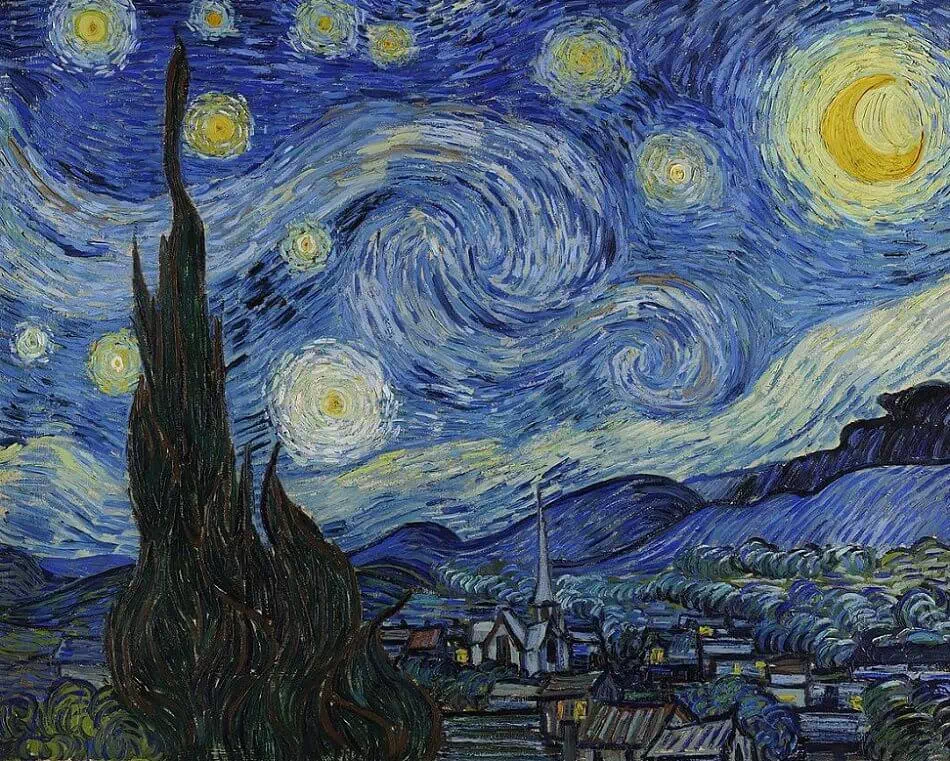
The Starry Night is so famous that does not even need an introduction. The painter of this art piece is the “mad” painter Vincent Van Gogh 1889 while he was staying in an asylum recovering from mental illness.
This particular painting simply triumphs over his other masterpieces. It influences the modern-day art movement Expressionism. The use of vibrant colors, brushwork, the stars, the moon, and the symbolical Cypress tree- all of the elements have made the painting a brilliant work of art.
However, the painting hangs permanently in The Museum of Modern Art in New York City.
Vector Design US, Inc. offers photo retouching services. Do you need retouching? Contact us.
The Last Supper by Leonardo Da Vinci

The Last Supper is another of Vinci’s indications of his genius mind. The antique painting has a long explanation both from the religious and artistic points of view. It is influenced by the biblical event when Jesus has just declared that one of his companions is going to betray him.
The old painting captures the dynamic moment of the companions’ reaction to hearing Jesus. The perspective, the angles, the hidden meanings, use of architectural aspects all work harmoniously to make the art find its name in the list of the most popular paintings by Leonardo Da Vinci.
Vinci painted it between 1495 and 1498 for the Santa Maria Delle Grazie in Milan as a wall painting.
The Birth of Venus by Sandro Botticelli
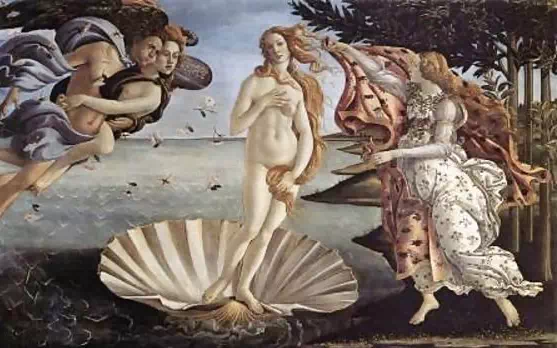
Sandro Botticelli painted The Birth of Venus inspired by the mythical story of the birth of Venus, the goddess of love and beauty during the early Renaissance era. According to the myth, Venus rode on a seashell to Cythera Island.
However, in the painting, Venus is in the center, on her left side Zephyrus and Chloris who blew the wind to guide the goddess. On the seashore, the goddess of spring, or arguably Pomona moved forward with a rosy mantle in her hand. The painting is unique in many ways.
First of all, nude art was a bold work at that time due to the Christian influence. Secondly, it was painted by tempera on canvas instead of popular wood panels. Now the painting belongs to the Uffizi museum, Italy.
The Creation of Adam by Michelangelo

The creation of Adam by brilliant renaissance painter Michelangelo is one of the many biblical images from the Sistine Chapel ceiling. It is inspired by the story of creating the first man, Adam, from the book of Genesis.
In the painting, there are two central figures- Adam and God. God is shown as a mighty, elderly, muscular man with grey hair and a long beard. The depiction of God reflects the belief that man is created in the image of God.
The Kiss, Famous Paintings of the World

The Kiss by Austrian painter Gustav Klimt is the most famous and iconic artwork attracting visitors from all over the world to the Austrian Gallery, Vienna, where it is permanently placed. The painting depicts a sensual and erotic kiss by a couple draped in rich patterned clothes.
It is painted with oil on canvas with gold leaves, silver and platinum added to it. Klimt is known as a symbolist and the painting bears the indication of it. Using gold leaves has made the work unique and appreciated universally.
Guernica by Pablo Picasso

Painted in 1937, Guernica is one of the most famous artworks by the phenomenal Spanish artist, Pablo Picasso. It is a grey, black and white oil painting regarded as modern art. Picasso painted it during the Spanish Civil War on an immediate reaction to the Nazi’s disastrous bombing practice in Guernica.
The painting provides a string anti-war message picturing the devastating nature of war. Picasso has used a bull and a horse that are related to Spanish culture as the most important characters of his painting. Arguably, the bull is the representation of the Fascist Nazi and the horse represents the common people of Guernica.
Wanderer above the Sea of Fog by Casper David Friedrich
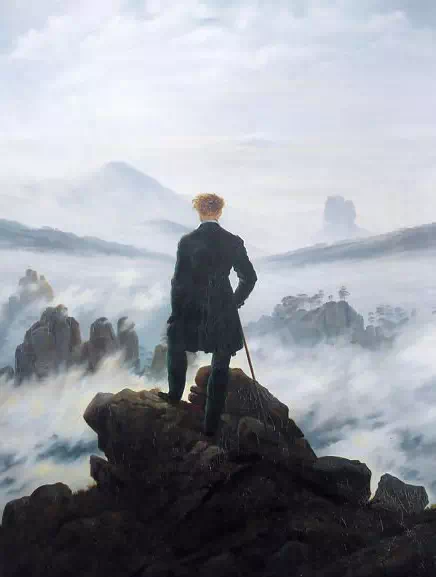
Casper David Friedrich is a famous German romantic artist who painted one of the most famous paintings of the world of all time- Wanderer above the Sea of Fog or Wanderer above the Mist in 1808. Now it belongs to the Hamburger Kunsthalle of Hamburg, Germany.
It is an oil painting that shows a man standing on a rock looking at the mist and fog. The contrast between light and dark, white and black has made the painting an extraordinary one. It is a true representation of a romantic man who has a deep fascination for nature.
School of Athens by Raphael

The timeless painting School of Athens by Raphael is a pure presentation of philosophy. It depicts all the greatest mathematicians, philosophers, astrologists, and Scientifics gathering in the hall and immerged in their activities. Plato and Aristotle are seen discussing with each other in the middle of the crowd. There is also Ptolemy and Pythagoras busy with their studies and theories.
Raphael made his work stand out showing the true spirit of the renaissance and the upcoming days of knowledge and education.
Sunflowers by Vincent Van Gogh

Sunflower is one of the most famous paintings by Vincent Van Gogh. It is from his Sunflower series where he painted almost twelve pictures similar to this one. He worked this series while staying in Arles around 1888 to 1889. It was a part of his experiments with vibrant colors. The sunflower is symbolized gratitude and harmony here.
Now the painting is a part of the collections of the National Gallery of London.
Irises by Vincent Van Gogh
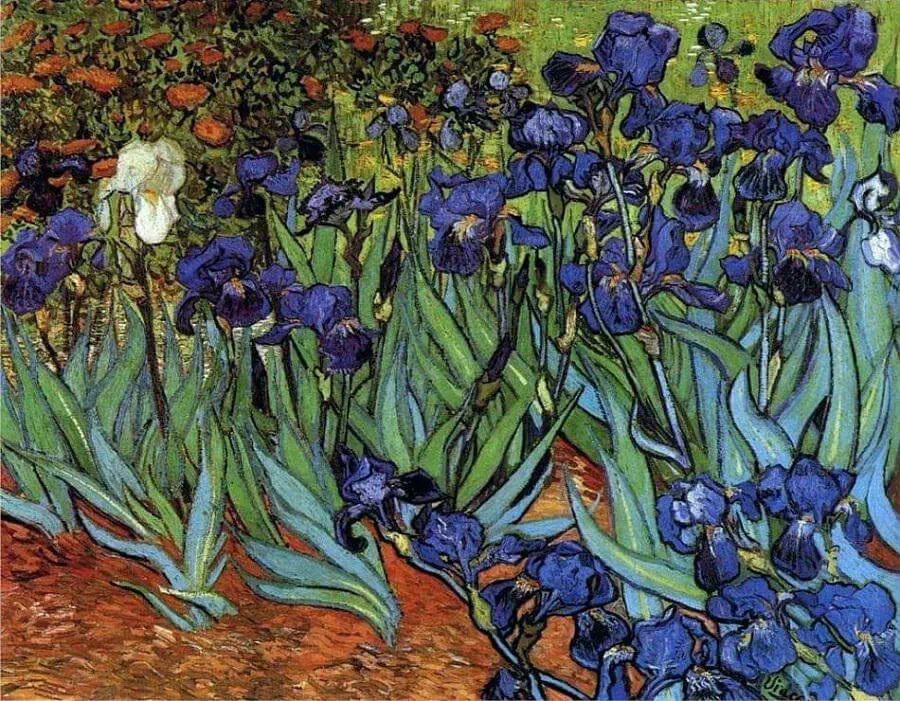
Gogh painted the Irises while staying in the asylum of Saint Remy, which was originally a monastery. There he got his most needed isolation from the world to indulge himself in his work. The Irises is presumably among the first awesome paintings he did at that time as there was an area full of Irises in the asylum. He showed his true talent in depicting movement in the still flower like this.
In 1990, the painting was bought by J.Paul Getty Museum, and still, it remains there.
View of Toldeo by El Greco
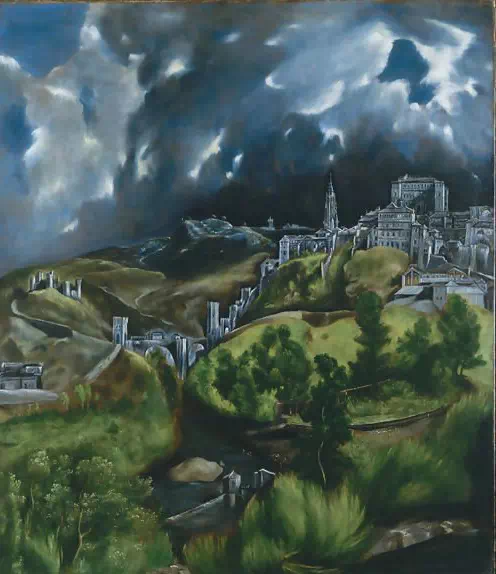
Painted by famous Greek painter El Greco, the View of Toledo is one of his surviving landscape artworks. The landscape here is not meant to show how the place looks. Rather, it shows what the place feels like. It is painted with dark, deep, and moody colors like blue, black, green, and white that depicts a stormy sky that cracked open to the city.
Also, the buildings give an impression of movement that makes the entire painting a dynamic and alive one. The great art belongs to the Metropolitan Museum of Art in New York City at present.
Persistence of Memory by Salvador Dali

The famous Surrealist Spanish painter Salvador Dali painted the Persistence of Memory in 1931. It is one of the early examples of using surreal conceptions in art. The melting watch is related to Dali’s concept of softness and hardness. He titled the pocket watch as the ‘camembert of time.’
According to Dali, the slow melting pocket watch represents the subconscious paranoia of the human mind about the short life and time on earth. The three watches represent the concept of past, present, and future.
Besides, Dali showed the theme of metamorphosis as well in the painting. The central figure is a bit controversial and has lots of theories. Among them, the most popular one is that it is Dali’s self-portrait presenting as a metamorphosis.
Café Terrace at Night by Vincent Van Gogh

Café Terrace at Night is one of the three beautiful paintings of Van Gogh where his iconic starry sky makes an appearance for the first time. The most interesting part of the painting is though it is nighttime it is devoid of black color. Instead, it has rich blue, orange, and yellow colors dominantly.
However, Gogh painted it from his memory but the café really exists. To him, the night was more vibrant than the day. The position of the stars is so accurate that the astronomers have correctly traced the date out of it. The date of this beautiful drawing was 16 or 17 September 1888.
The Fall of Icarus by Pieter Bruegel the Elder

Pieter Bruegel the Elder painted the awe-striking art piece The Fall of Icarus or The Landscape with The Fall of Icarus probably in 1558 with oil on canvas. It shows the mythical story of Icarus. He got a pair of wings with beeswax and features from his father. He succeeded in flying but went too close to the Sun and later met his tragic death.
The painting shows Icarus who has just fallen into the water. His surrounding is totally indifferent and continues to move on even after the fall. It suggests humankind’s ignorance of the sufferings of others.
The Hay Wain by John Constable
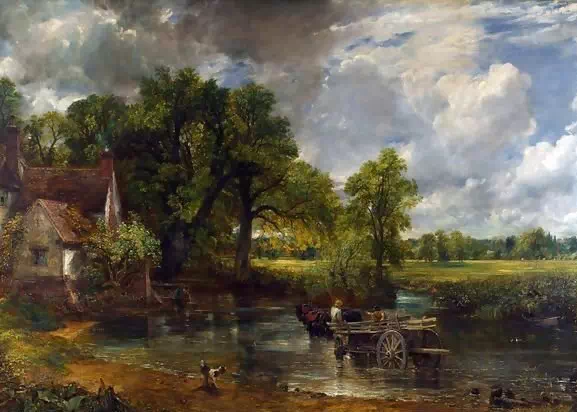
British artist John Constable painted The Hay Wain in 1821. It was previously familiar as the Landscape: Noon. It depicts a pastoral, rural image on the River Stour of England. Undoubtedly it is one of the most famous English paintings as it got its place in the Victoria and Albert Museum in London.
There are multiple subjects in the painting. Among them, the three horses pulling a wain or wagon, Willy Lott’s Cottage, the farmers at distance working on the field, the girl washing clothes are most notable. Also, there is a stark contrast between the sky and the land.
The Transfiguration by Raphael
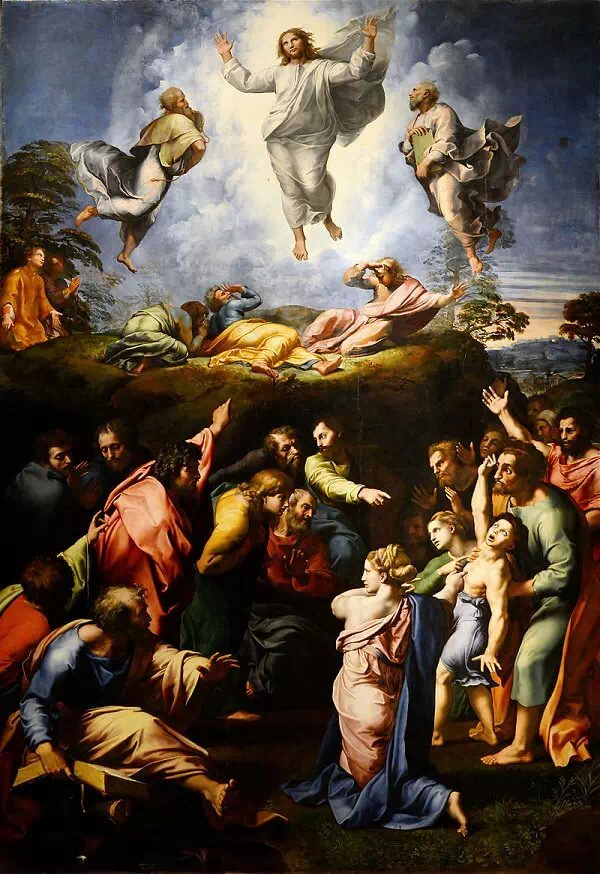
The Transfiguration is arguably the last painting of the renaissance painter Raphael. It has two different parts. The first one is the figure of Jesus Christ accompanied by Moses and Elijah on Mount Tabor. An aura of light and dramatic cloud is in the background. On the land, there is a possessed boy along with some of the disciples of Christ who made them astonished.
The painting shows the great mastery of Raphael on painting and his brilliant use of colors to create an aura, lights, shadows, and figures.
Happy Accident on the Swing by Fragonard

The Swing is an oil painting by French painter Jean Honore Fragonard. The people regarded it as one of the best paintings of the Rococo era.
It shows a young woman in a rope swing and below her, a man is hiding in the bush. An old man is there who is tugging the rope for the lady. There are two statues popular as Putto and Putti. However, one of the lady’s shoes is flying in the air. In a word, the whole painting is extremely dynamic and lively.
Luncheon of the Boating Party by Pierre-Auguste Renoir
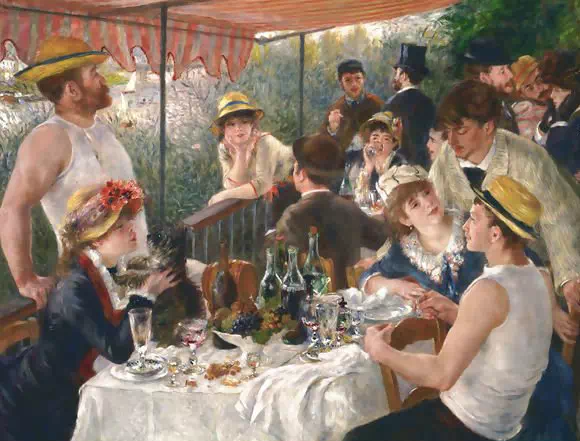
Luncheon of the Boating Party is a painting by French impressionist Pierre-Auguste Renoir. It is an oil on canvas painting that depicts the brilliance of brushwork, rich form, and the use of light. It is basically a combination of still life and landscape.
The people of the painting are all friends of the painter who are sitting, gossiping and relaxing at a boating party. However, there is a contrast between emptiness and fullness in the painting. If you ponder, you see it clear with the railing. The most notable thing in the painting is the flickering light that dominates the whole work.
The Third of May by Francisco Goya
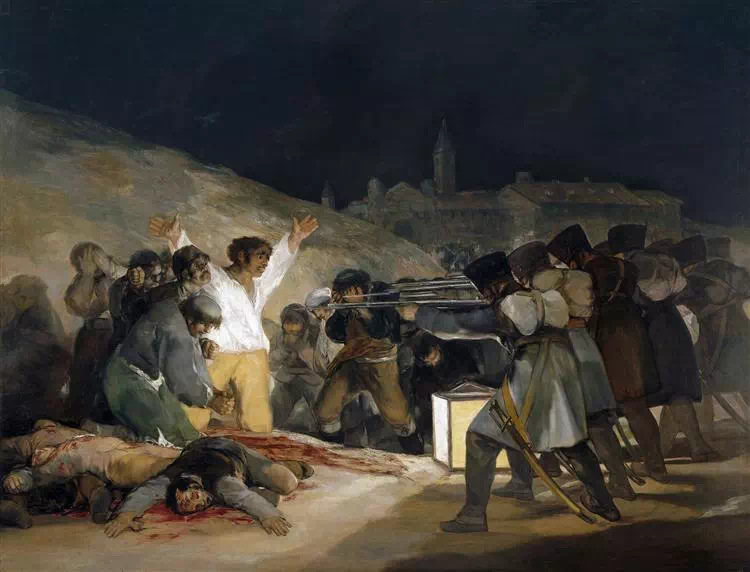
Francisco Goya is one of the most influential Spanish painters. We know him as an early modernist who brought a unique style to his beautiful paintings at that time. The 3rd of May is his most popular work presenting an anti-war message. It is a historical painting as well since it shows the attack of Napoleon’s army on the Spanish during the peninsular war.
Goya finished his work on it in 1814 and now it is permanent in the Museo Del Prado, Madrid.
Lady With an Ermine by Leonardo Da Vinci
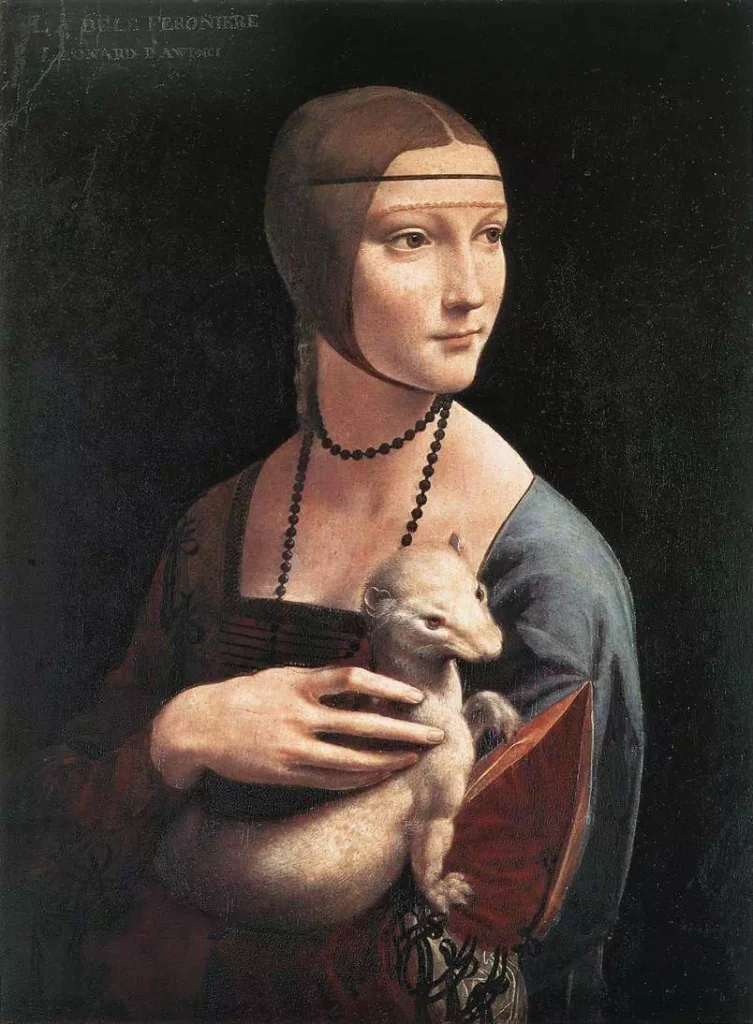
Lady with an Ermine rightfully belongs on the list of famous artworks of all time. It is another Renaissance painting by Leonardo Da Vinci around 1489-1490. The portrait depicts a young woman probably the mistress of Lodovico Sforza, Duke of Milan, Cecilia Gallerani with a soothing and gentle face holding an ermine with tender hands. It is an oil painting with a walnut board.
However, the painting now belongs to the Czartoryski Museum in Poland after the Young Prince, Adam Czartoryski bought it from Paris during his tour to France for his mother.
Sistine Madonna by Raphael
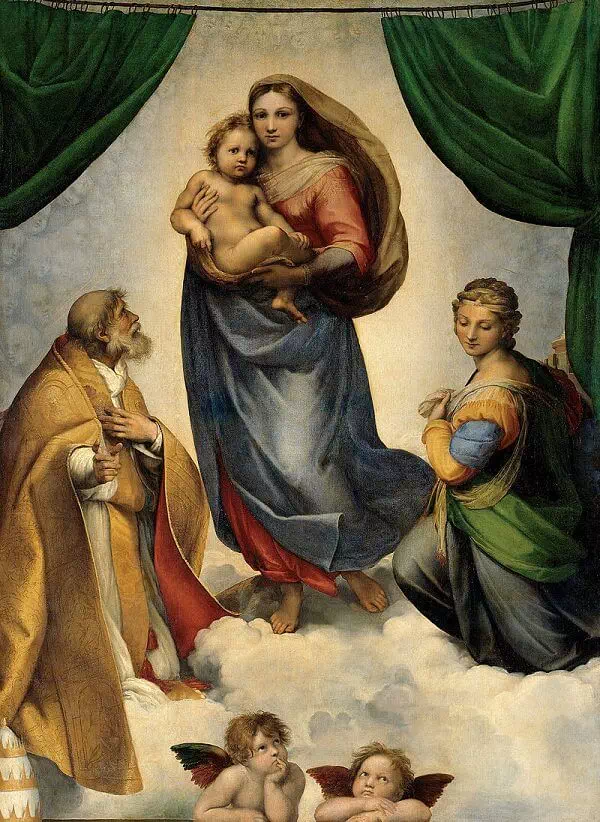
Sistine Madonna is another great painting of Raphael. It shows that Madonna is carrying the infant Jesus. St Sixtus and St Barbara are available in a lower position than Madonna. In the lowest portion of the painting, there are two angels. They are the cherub who gives an intense look. Here Jesus and Madonna’s face does not give a happy expression presumably fearing something dreadful.
The art piece now hangs in the Gemäldegalerie Alte Meister of the Staatliche Kunstsammlungen Dresden in Germany after the Soviets returned it as a gesture of goodness.
Olympia by Edouard Manet

French artist Edouard Manet’s oil painting Olympia is one of the most controversial paintings in the world. Edouard painted it in 1863 during the period of realism and impressionism. Now we can see it in Musée d’Orsay, Paris.
The painting depicts a nude woman and her black servant. The critics presume the nude figure as a prostitute because of many suggestive elements such as the exotic shawl, the bracelet, the ribbon around her neck, and the orchid on her hair. All of these elements make her appearance extremely sensuous and alluring.
The Great Wave of Kanagawa by Hokusai

Hokusai is one of the most famous Japanese artists, well known for his series of thirty-six views of Mount Fuji. Among them, The Great Wave of Kanagawa is the most iconic one, regarded as one of the best paintings from Japan.
The painting is in landscape format contains three central elements: the sea, the mountain, and the three boats. The colors like dark blue, white, and grey have made the painting a meaningful and symbolic one.
Also, the energetic sea wave shows the mighty power of the sea symbolizing the great force of nature in contrast to the weak humans.
The Nude Maja by Fransisco Goya
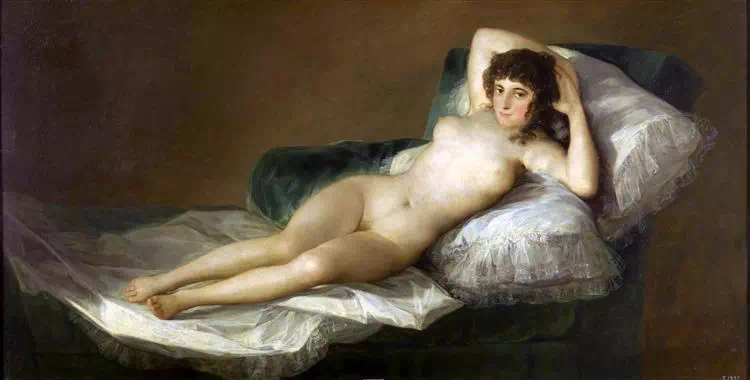
The Nude Maja or La Maja Desnuda is famous oil on canvas painting by Fransisco Goya who depicts a young and sensuous nude woman with an alluring look on her face.
Manuel de Godoy preserved this painting as a part of his own collection of nude paintings. It created great controversy and later Goya painted another version of the Nude Maja, the Clothed Maja. In the Museo Del Prado of Madrid, both the paintings are staying side by side.
Almond Blossom by Vincent Van Gogh
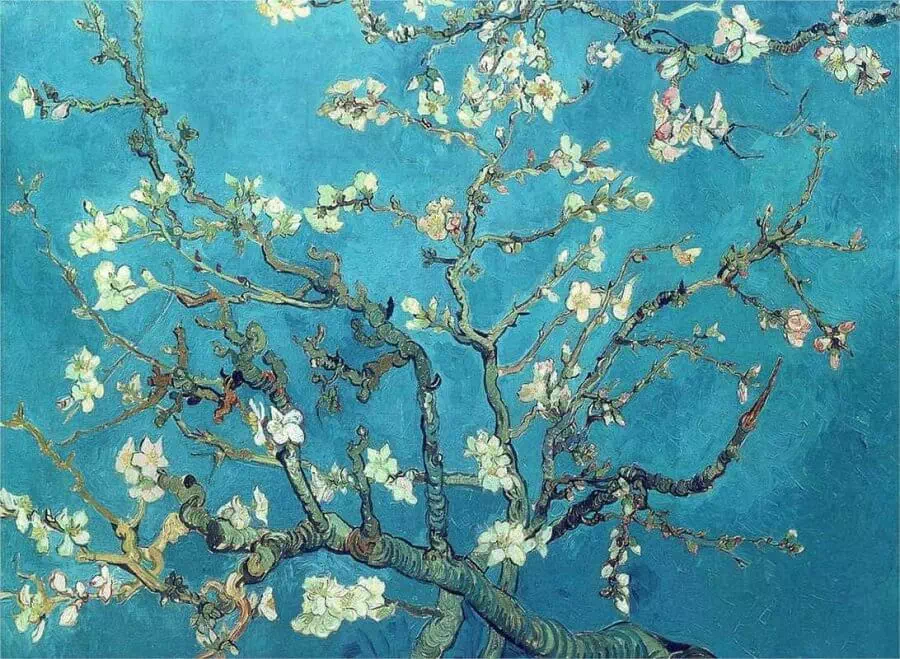
Van Gogh painted one of his personal favorite paintings in 1890 as a gift to his nephew. He regarded it as the “best and most patiently worked thing.” It is a sign of new hope and optimism to him. The painting is strongly a silent protest against Impressionism, Divisionism, and Japanese woodcuts style.
It bears notable elements of Japanese Ukiyo’e Print that are fascinating. It has bold outlines of the tree branches, vivid colors, masterful brushwork, and no horizon to show a perspective.
Dora Maar au Chat by Pablo Picasso
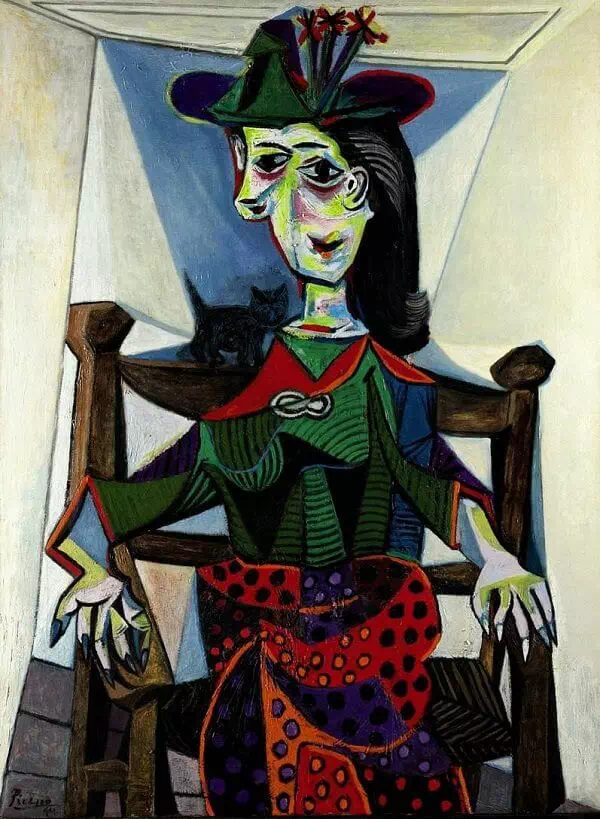
Dora Maar au Chat is a brilliant portrait by Pablo Picasso that bears the signature of surrealism. It is the largest portrait that he did which later became one of the most expensive paintings of all time.
The model of the portrait is Dora Mar, Picasso’s mistress, and motivator. He has depicted her with vibrant colored clothing and a peculiar hat that connects him with the surreal movement. Picasso did not want to show her beauty but her temperament.
The black cat on her shoulder represents female aggression and sexuality. As a whole, the painting is captivating and mysterious.
Massacre of the Innocents by Peter Rubens
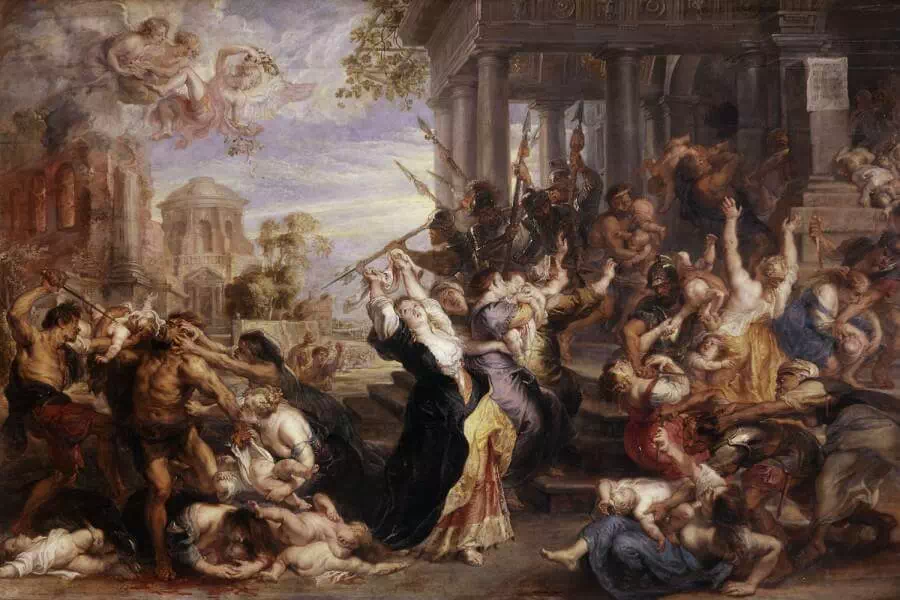
The Flemish artist Peter Ruben painted his masterpiece The Massacre of the Innocents in 1610 in where he depicted a biblical event of slaughtering innocent children in Bethlehem from the Book of Mathews. King Herod ordered his soldiers to kill all male children from the town and the women were trying to protect their babies.
The panting shows despair, destruction, and the horrors of war. Ruben got inspiration from the Italian renaissance painters and implies several elements from them into his own work. Now the art piece belongs to the art gallery of Ontario in Toronto.
The Scream by Edward Munch

Edward Munch is a Norwegian painter and his most iconic painting is The Scream. He bring the painting into the light in 1893. Munch took inspiration from his own life when he was walking and suddenly noticed how the setting sun turned the sky red.
This screaming face is the representation of human anxiety and fear for entering into a new century that is going to bring modernity, conflict, and industrialization. The two boats in the background represent the calm and quiet pre-1900 Europe which is fading away.
American Gothic by Grant Wood
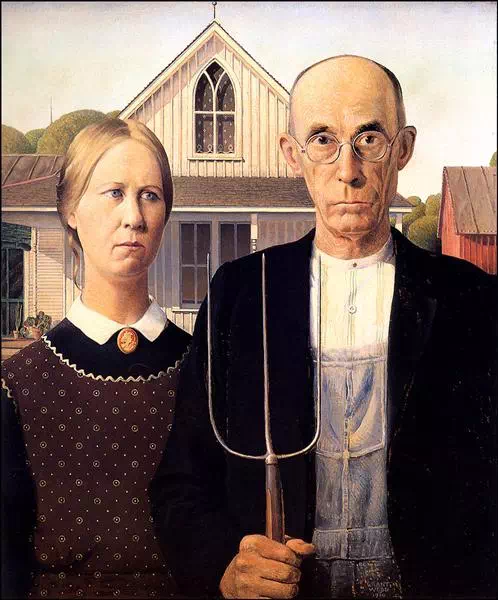
The American Gothic is one of the most influential American paintings. Grant Wood painted it in 1930. He took an interest in a wood farmhouse with a window known as ‘carpenter gothic’ in the town of Eldon, Lowa. His sister and his personal doctor modeled for him, helping him to depict the farmer and his daughter.
Wood got influenced by Flemish Renaissance art and applied several elements of European style in his art. The art lovers interpreted the painting several times from multiple angles. It represents the great depression of America and the constant pressure of capitalism on human lives.
A Sunday Afternoon on the Island of La Grande Jatte by Georges Seurat
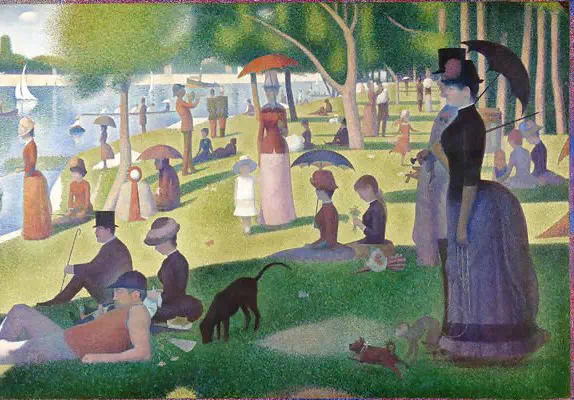
A Sunday Afternoon on the Island of La Grande Jatte by Georges Seurat is popular for many reasons. It is an early example of a pointillist technique where the artist uses small dots to create a stunning image. Also, it is the pioneer of the Neoimpressionist movement in art.
However, Seurat depicted a group of people relaxing in a park on the La Grande Jatte Park in the Seine River. The painting still fascinates people having elements of self-contradictory nature. It is beautiful, silent, and sunlit on one level but it is disturbing, noisy, and shadowy on another level.
Medusa’s Raft by Theodore Gericault

French romantic artist Theodore Gericault painted the Raft of Medusa in 1819m, depicting the gruesome event of a shipwreck, death, and destruction. The wreck of Frigate Meduse, a French ship inspired him where 15 people died, and many of them experienced starvation and dehydration resulting in cannibalism.
Instead of choosing something beautiful to paint, Gericault chose the disturbing subject for his art which makes him a standout among his fellow painters. That is the reason he is popular as a romanticist and appreciated worldwide.
Self-Portrait by Vincent Van Gogh
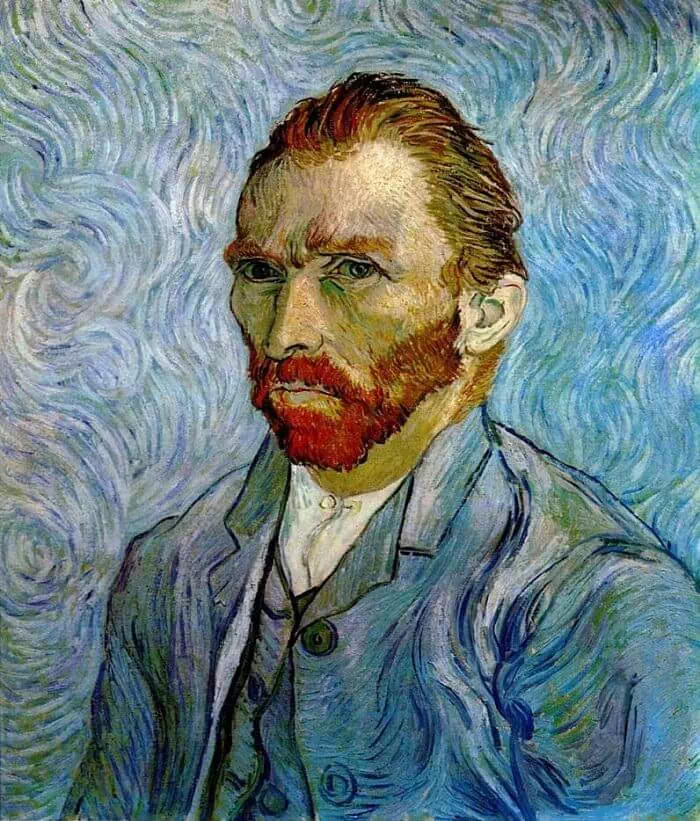
Van Gogh created his last self-portrait in 1889 before his death. He always wanted to create his own image as he painted around 30 portraits that significantly bear his inner psychological turmoil and conflicts. Self-portraits are a recurring subject of Van Gogh’s painting.
The pattern of the background reminds us of his icon starry night motif and represents the compulsive state of his mind. This particular portrait is mature, aggressive, and confident.
The resemblance between his coat and the background shows that he is not anymore for harmony and tranquility rather his mental state has reached such a stage where he rejects the outside world and wanted to stay in his inner world.
The Bridge at Narni by Jean-Baptiste-Camille Corot

The Bridge at Narni is a famous landscape painting by Jean-Baptiste-Camille Corot in 1826. He was a traveler and it gave him the chance to come across beautiful landscapes that later inspired him to create exclusive paintings like this. In 1826, Corot visited the town of Narni on the River Nera and there was a roman bridge. Carot got a fascination with the view and painted the famous painting the Bridge of Narni.
Arnolfini by Jan Van Eyck

Arnolfini by Jan Van Eyck is an oil painting depicting a double portrait of the merchant Giovanni di Nicolao Arnolfini and his wife. They are standing in their private chamber and its decoration is showing a sign of their aristocracy.
There are many figurative elements in the room suggesting many inconsistencies along with the wealthy representation of the room. There is a mirror on the wall that shows there are two more figures approaching. Because of the extensive details and brilliant brushwork, the painting never fails to amaze the viewers.
The Starry Night Over The Rhone by Vincent Van Gogh

Starry Night over the Rhone is among those three paintings that Gogh painted with the starry night theme. He did it while he was staying in the Yellow House in Arles. Gogh depicted the painting at night. It allowed him to draw the gaslighting on the blue water of the river Rhone.
The rich blue color along with yellow and black have made the painting the signature style of Gogh. Two lovers are also wooing in the foreground connecting the ethereal nature with the human world.
Dogs Playing Poker by Cassius Coolidge

Dogs Playing Poker is a painting series comprised of eighteen paintings by Cassius Coolidge. He is an American painter and his ‘Dogs playing Poker’ series is one of the most influential paintings in American Pop culture. The particular painting we have presented here is familiar as a ‘Poker Game’ painted in 1903.
A cigarette company Brown & Bigelow commissioned him to paint the art as part of their advertisement. Later it became popular and got a position in calendars, mugs, t-shirts, and so on.
Les Demoiselles d’Avignon by Pablo Picasso

Les Demoiselles d’Avignon or the Brothel of Avignon is one of the largest paintings of Pablo Picasso. He depicted five nude prostitutes from a brothel in Barcelona.
All the female figures have a distinct style and their appearances do not indicate female naivety or coyness. Picasso did not go for the traditional style of presenting women in art. Rather he used geometric patterns to depict their faces and bodies.
Arrangement in Grey and Black No. 1 by James Abbott McNeill Whistler

Arrangement in Grey and Black No. 1 or The Whistler’s Mother by James Abbott McNeill Whistler is a famous American artwork. Though its ownership now belongs to France, it is one of the most influential paintings of America.
The painter has used his mother as a subject for his painting. It created much controversy, yet it got recognition and popularity. The name of the painting has the word ‘arrangement’ that is peculiar for a painting but Whistler found music and often used musical terms as their titles.
The Garden of Earthly Delights by Hieronymus Bosch

The Garden of Earthly Delights is a triptych oil painting by Hieronymus Bosch between 1490 and 1510.
It has three panels known as left panel, center panel, and right panel. All three parts depict distinct subjects but all are essentially moral, religious, and full of symbols. However, they show a visual representation of fears and worldly activities. Now the painting belongs to the Museo del Prado, Madrid.
Liberty Leading the People by Eugène Delacroix
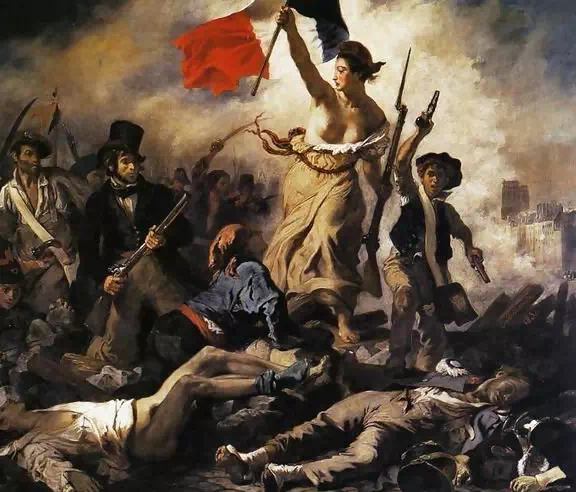
Liberty Leading the People is an oil painting by Eugène Delacroix depicting the July revolution that took place in Paris and removed King Charles X. Eugène Delacroix shows a woman holding the flag of the French revolution known as the tricolor flag leading people toward liberty over a barricade and dead bodies.
The woman is wearing a Phrygian cap which symbolizes the liberty of the first French revolution in 1789. The painter received mixed reviews for this art but later it became one of the most iconic paintings. Now it is a part of the Louvre Museum collection.
Nude Descending a Staircase by Marcel Duchamp
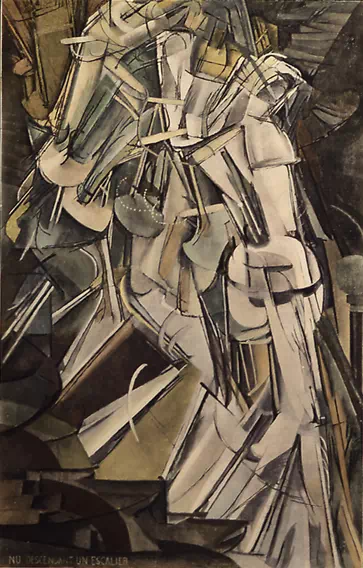
French artist Marcel Duchamp painted the famous painting Nude Descending a Staircase in 1912. Though he did not get appreciation overnight now people consider the art piece as one of the best modern paintings in the world.
It shows an abstract depiction of a figure walking down a staircase. Whether the figure is any human is unknown. It combines both cubist and futuristic elements. Now it is a part of the Walter Arensberg Collection of the Philadelphia Museum of Art.
The Ambassador by Hans Holbein the Younger
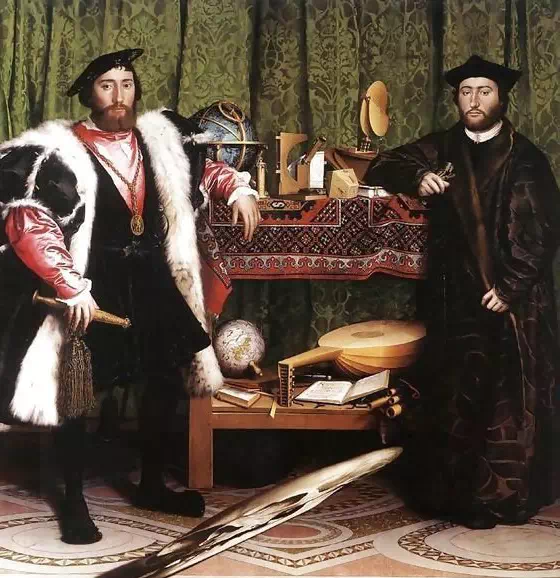
The Ambassador by Hans Holbein the Young is an oil-on-oak painting created during the Tudor period. It depicts two men – Jean de Dinteville who is a France ambassador from King Francis I and the bishop of Lavaur, Georges de Selve.
The carpet over the table is a ‘Holbein Carpet’, an exotic and aristocratic item. The table is full of items such as a globe, a sundial, a hymn book, an arithmetic book, a lute, and many more exotic items.
Along with them, there is a skull in anamorphic style in the front as a part of ‘vanitas’ or ‘memento’.
Nighthawks by Edward Hopper
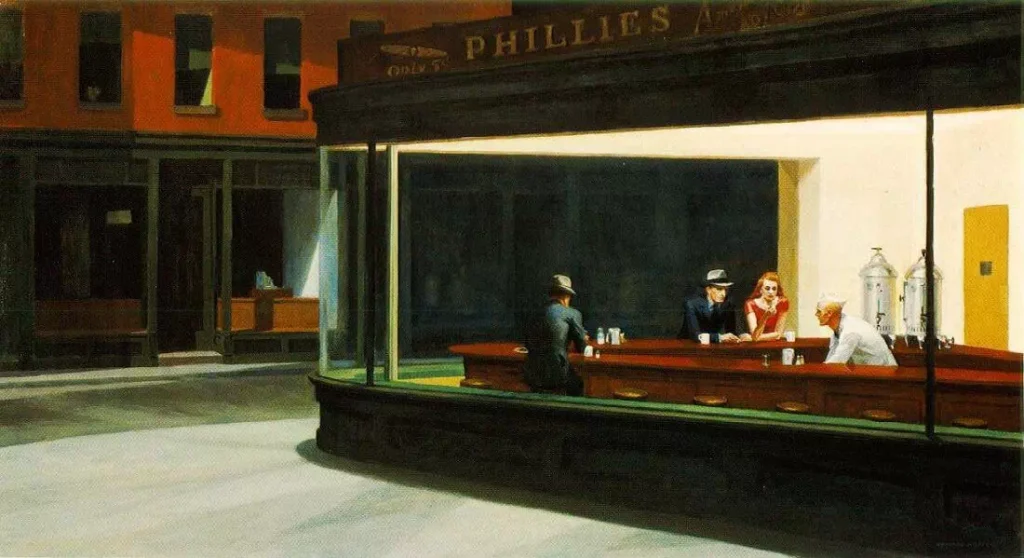
Nighthawks is a famous American painting by Edward Hopper depicting a downtown diner at night. It is an oil on canvas painting created in 1942.
The diner is in a dark street where four people are sitting. A small restaurant on Greenwich Avenue New York inspired Hopper. He saw it as a universal representation of urbanization. There are people spending time in it suggesting human isolation from each other because of extreme urbanization.
Rain’s Rustle by Leonid Afremov

Rain’s Rustle is a famous painting by American- Israeli painter Leonid Afremov. He is a contemporary impressionist and known for creating vivid, colorful, and expressive arts. Rain’s Rustle is an oil painting where he has depicted a rainy night.
A couple is walking with an umbrella under a canopy made by trees. Street lights from each side of the road have created a dreamy ambiance. The spectators appreciated the painting because of the bright colors and the meaning behind it.
Three Musicians by Pablo Picasso

Painted in 1921, Three Musicians is another of Picasso’s iconic works with a 2-meter height and width. He applied Cubist style in this painting transforming the subject into a sequence of abstract geometric lines, arcs, and planes.
There are three musicians in the painting with bright colors and abstract appearances. The left one is a clarinet player, the middle one is a guitar player and the right one is holding a paper of musical note. All the elements of the painting are in flat shapes.
The Night Café by Vincent Van Gogh
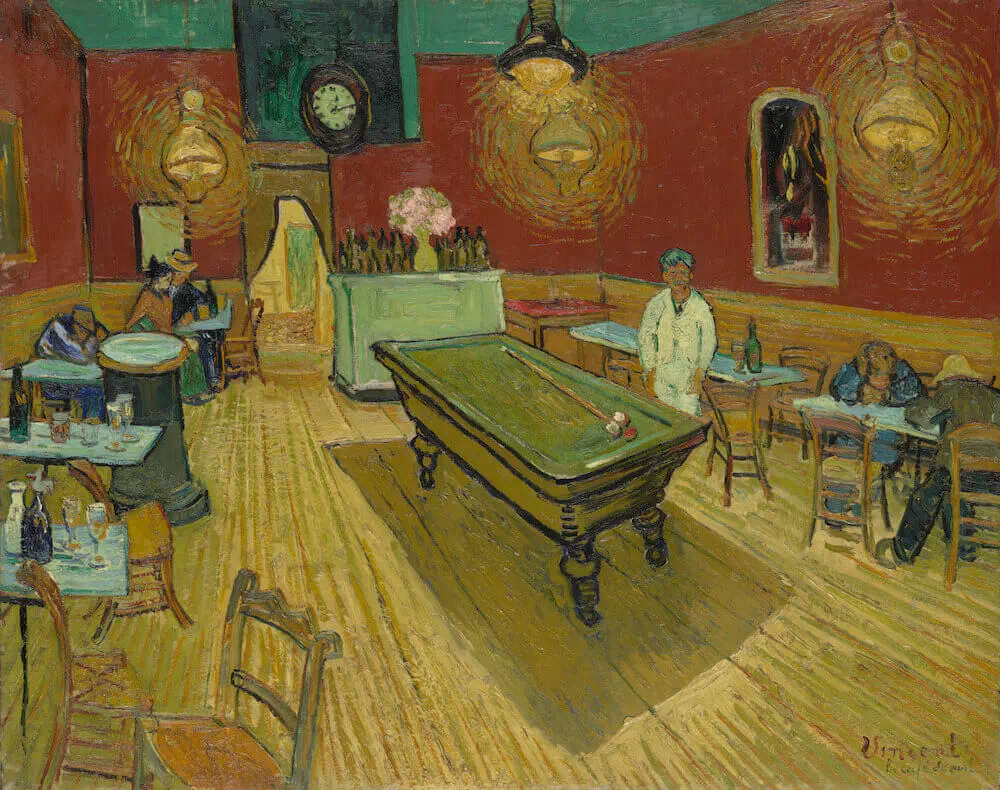
The Night Café is another of Van Gogh’s masterpieces. He painted it in 1888. It shows the interior of a café with the use of rich and vivid colors. The presentation is not upward but at a downward angle.
According to Gogh, the contrast between the colors red and green creates an illusion of vibration inside the café. However, the painting is full of life and uniquely vigorous. Now the Yale University Art Gallery is the owner of this famous art piece.
Impression, Sunlight by Claude Monet
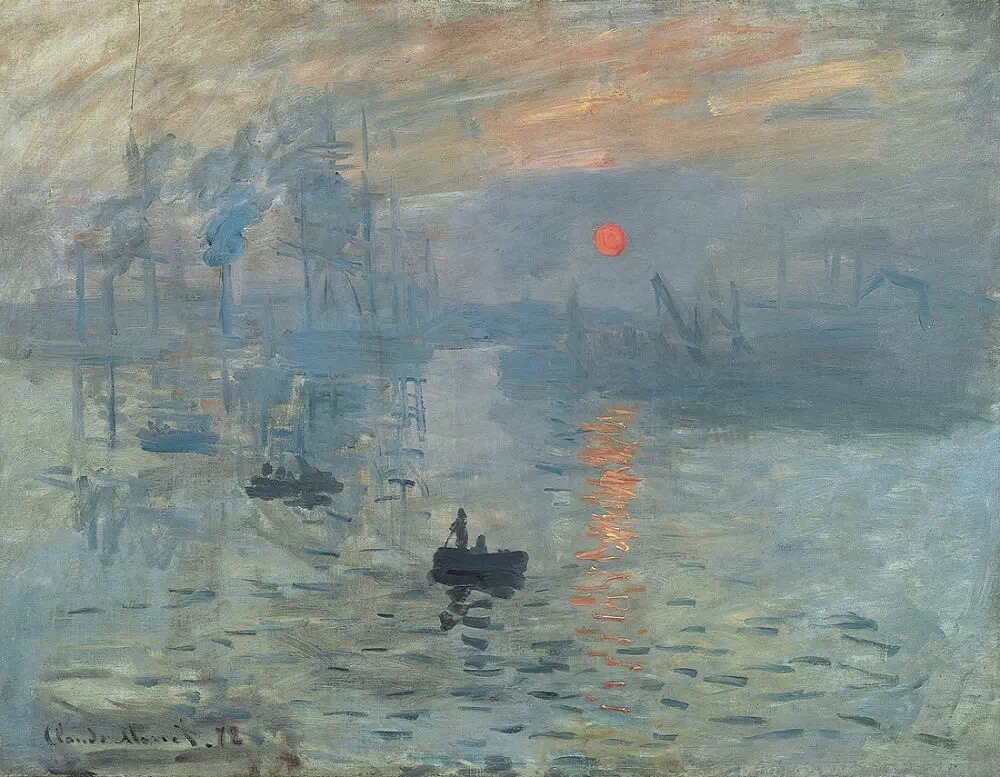
Impression, Sunlight by Claude Monet is an early example of Impressionism. The painting is in landscape style depicting a sunrise in the port of Le Havre with a hazy ambiance. There are some boats in the river along with some misty shapes on the horizon. The painting is showing the rebirth of France with its beauty and power.
However, the painting is much appreciated because of its colors and elements of Impressionism. It is now a part of Musée Marmottan Monet in Paris.
Christina’s World by Andrew Wyeth

Christina‘s World is another famous American painting by Andrew Wyeth. It is one of the best-known American paintings in the realist style. The central figure, a woman, Christina is lying on a field facing a gray house. The house has trees, a barn, and other small huts.
Overall the painting provokes nostalgia and presents a pastoral picture of rural America. Besides, the landscape is titled Christina’s World, suggesting it is more of a mental portrayal than a physical place.
The Fighting Temeraire by JMW Turner

The Fighting Temeraire is a famous painting by one of the best artists of England, Joseph Mallord William Turner, 1838. It depicts a warship Temeraire, one of the last ships to participate in the War of Trafalgar.
It symbolizes the eventual decline of the British Navy. The setting sun from the opposite side is the symbol of the end of an era for England. Also, the moon suggests the upcoming new era marked by industrialization and modernity.
The Flower Carrier by Diego Rivera
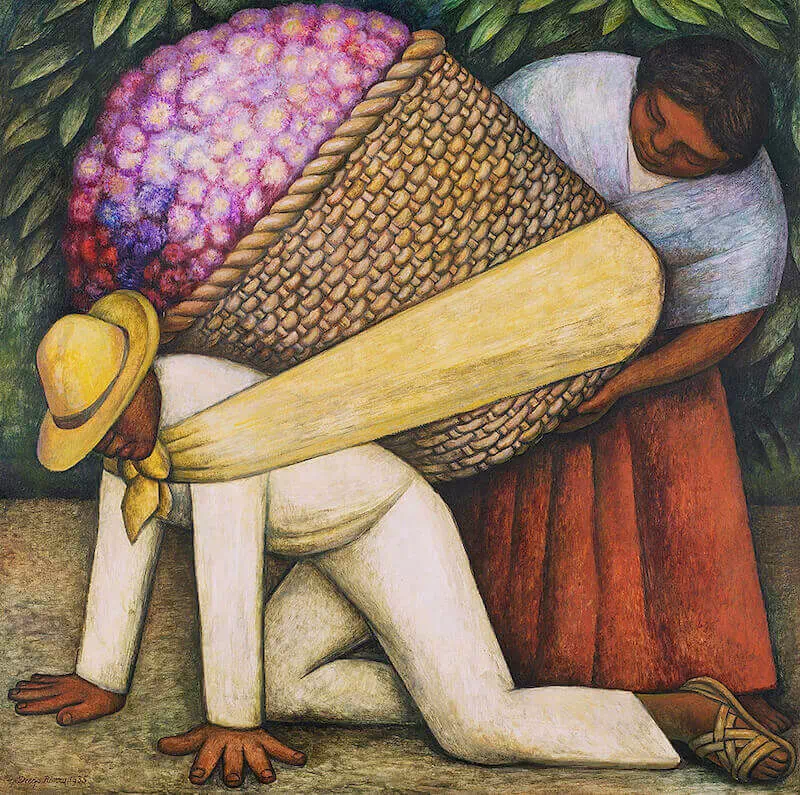
The Flower Carrier by Diego Rivera is oil on tempera painting done in 1935. It is one of the most famous and iconic arts of Rivera.
It depicts a man trying to get on his foot. An overloaded basketful of flowers is on his back. The flowers are colorful and charming yet they don’t give him pleasure. He is unable to carry the load. He symbolizes the laborers of the industrialized world who are too weak to work yet continue it for earning their livelihood.
Flaming June by Frederic Leighton

Flaming June is one of the most identical paintings by British painter Frederic Leighton depicting a young woman with several elements of realist style. The bright orange-colored dress with the brilliant brushwork feels so real that one can feel like almost touch it. The sleeping pose of the woman is more decorative than comfortable.
He got inspiration from the Greek style of depicting nymphs and goddesses and the Flaming June bears the proof of it. However, the painting is one of the best ones that belong to the Victorian era.
Saint George and the Dragon by Raphael

Raphael belongs to the High Renaissance period of Italy and is popular for many brilliant paintings. To celebrate the court of Urbino, Raphael painted a series of two miniature panels and Saint George and The Dagon is one f them.
The painting depicts Saint George putting on a blue garter about to slay a dragon for her daughter. It is a perfect representation of Renaissance spirit and ideals. Also, it is a true representation of Chivalry and Christianity which was essential to present to the celebration.
Annunciation by Leonardo Da Vinci
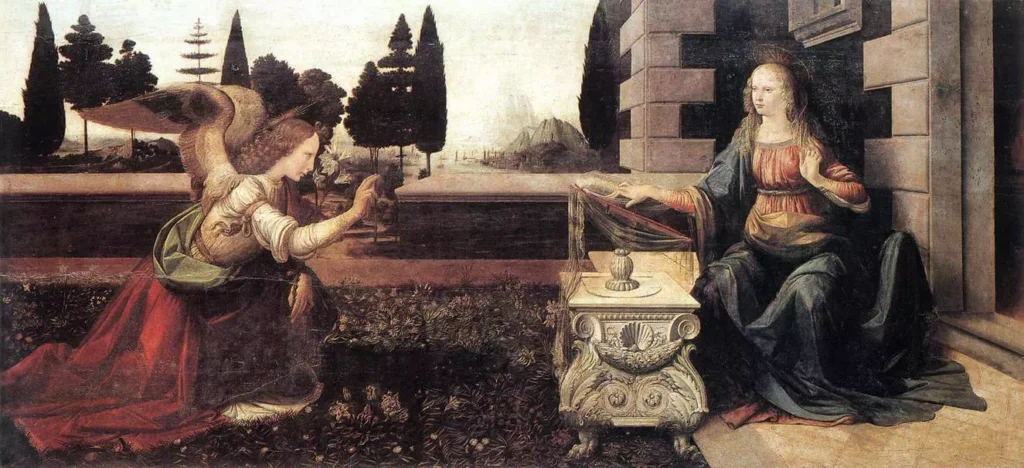
The painting depicts the famous story of Mary. Archangel Gabriel blesses her. She came to greet Mary with a lily in his hand. In reaction to his presence, Mary lifts her head and hand in astonishment. It is presumably one of the earlier works of Vinci during his time of apprenticeship with his master Andrea Del Verrocchio.
However, Vinci has used his recurring elements like the landscape, the mountains, the water in the background, etc. We find these elements in his other works as well. Now the great painting is resting on in the Uffizi, Italy.
Breezing Up by Winslow Homer

Breezing Up or A Fair Wind is another famous painting by American artist Winslow Homer done between 1873- 1876. It depicts a boat with a man and three boys enjoying the wave and the sun. The painting has rich use of colors, details, and a perfect combination of light and shadows.
The painting rightly represents the American life of hope, desire, and spirit. The man and the boys are boating on a mighty sea yet they seem relaxed and spirited. That is why the painting received universal recognition and appreciation.
The Ladies Waldegrave by Joshua Reynolds
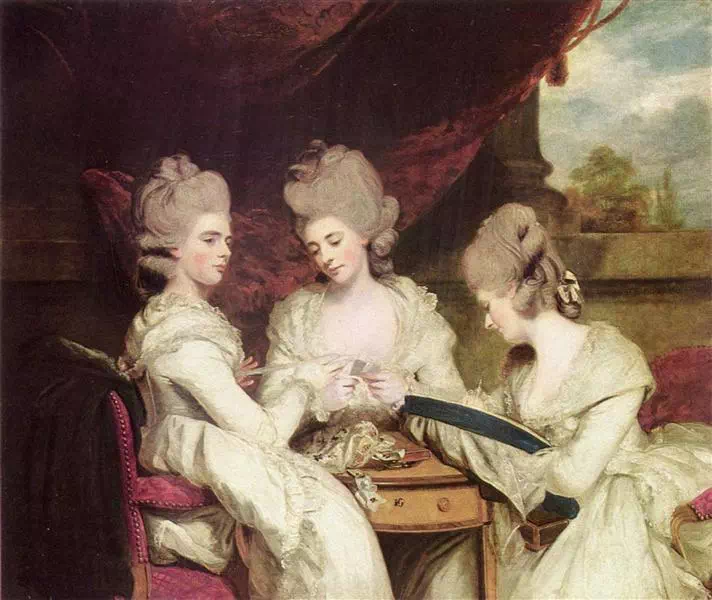
The Ladies of Waldegrave depicts three daughters of 2nd Earl Waldegrave in a portrait style. They are working collaboratively on some needlework. The left one is Lady Charlotte holding a skein of silk, the middle one Lady Elizabeth is winding onto a card and the right one Lady Anna is working with a frame.
The purpose behind the painting was to find potential suitors for the daughters. However, Joshua Reynolds has represented the aristocracy of contemporary families. It also connects us with the tradition of needlework practice for unmarried girls.
Et in Arcadia Ego by Nicolas Poussin

Et in Arcadia Ego or The Arcadian Shepherds is a famous painting of French Baroque style by the talented French neoclassical artist Nicolas Poussin.
The painter has drawn here a beautiful pastoral scene that shows three Sicilian shepherds and a shepherdess beside a decaying tomb in Arcadia. The middle one is trying to read something from the tomb. The painting speaks with the voice of the title “Even in Arcadia, there I am. Now the painting belongs to the Louvre Museum, France.
Watson and the Shark by John Singleton Copley
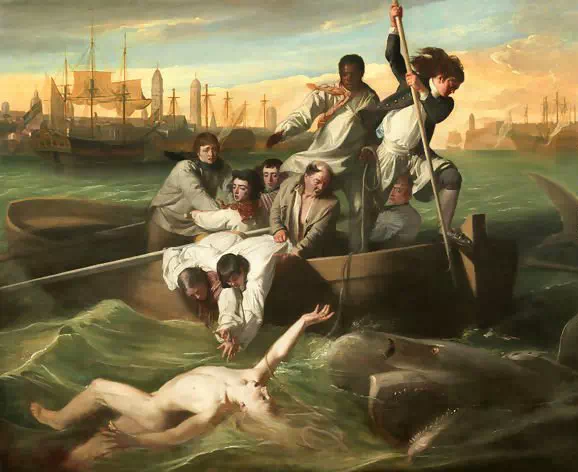
Watson and the Shark is a famous oil painting American artist, John Singleton Copley. The painting depicts the rescue of Brook Watson, an orphan boy who later became the Lord Mayor of London, from a shark attack that took place in 1749 in Havana. He lost his leg in the process and later, his companions rescued him on the third attempt.
The painting is the depiction of that incident. It is dramatic and dynamic being full of action. The composition shows a tiger shark about to attack Watson and the ten sailors are attempting to rescue him. Now, the painting is permanently a part of the Museum of Fine Arts, Boston.
The Avenue in the Rain by Childe Hassam

Childe Hassam was one of the “Ten American Painters”. The painter got inspiration from French art around 1898. Hassan was an impressionist as well. However, The Avenue in the Rain is one of his most prominent works. It depicts the Fifth Avenue of New York City showering in the rain, draping with the flag of the U.S.
During World War I, the management decorated the avenue regularly with flags. Hassam painted around 30 flag paintings at that time and this one is one of them. Now it is in the possession of the White House in Washington D.C.
Madame Recamier by Jacques-Louis David
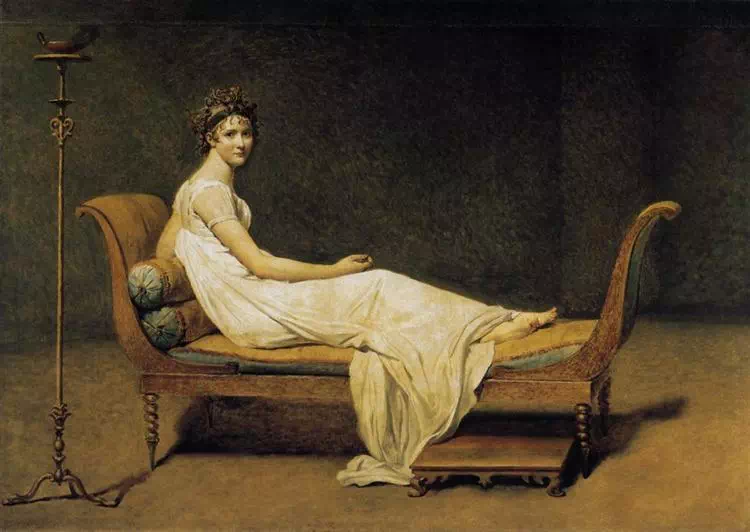
Jacques-Louis David was a prolific neoclassic French painter and his works are among the most celebrated paintings of all time. He painted Madame Recamier, who was the wife of a Persian Banker and the most beautiful woman of that time. Louise painted her in a vintage dress surrounded by Pompeian furniture.
The horizontal format of the painting was not a common style for portraits as it was for historical paintings only. Yet Louise chose the style for portraits and the world is appreciating it ever since.
Patrocles by Jacques-Louis David

Patrocles is an oil painting by Jacques-Louis David depicting the muscular physique of mythical warrior Patroclus. He was Achilles’ close companion in the Trojan War. Later Hector killed him engaging Achilles violently and dragging him into the war.
Jacques-Louis David was a neoclassic painter and the works of Caravaggio influenced greatly. He does not show his subject’s face only the nude part of his body.
Napoleon Crossing the Alps by Jacques-Louis David

Napoleon Crossing the Alps is a famous series of luxury paintings consisting of five oil on canvas portraits of Napoleon Bonaparte. Jacques-Louis David painted the portraits between 1801 and 1805 on the commission of the King of Spain.
These are arguably the most successful paintings of Napoleon Bonaparte. The ironic part is that the moment of horse riding is an extremely dynamic one yet Louise made it a still painting with the same lively style.
The Musicians by Caravaggio

The Musicians is a renowned painting by Caravaggio, the influential Italian Baroque master in 1595. Francesco Maria del Monte was the patron of Caravaggio and commissioned him to paint it.
The painting depicts four boys wearing classical costumes are playing music with instruments such as lute and cornetto. One of them is holding a musical score. The last boy is a representation of Cupid is reaching for some grapes. There is a violin in the painting that offers any person who wants to join them.
Narcissus by Caravaggio

Narcissus is the mythical character who fell in love with his own reflection. His obsession was so high that he died looking at him. Later he transformed into a beautiful flower. The painting tells the story of Ovid’s Metamorphosis.
Caravaggio, the famous Italian painter painted the character and his reflection in the water. He is surrounded by darkness that suggests the eventual downfall of him being too obsessed with his own himself. Now it belongs to the Galleria Nazionale d’Arte Antica in Rome.
The Sleeping Gypsy by Henri Rousseau

The Sleeping Gypsy is a fantastical painting depicting a lion and a gypsy woman at night. Henri Rousseau was popular as a naïve artist explains his painting by saying that it is a poetic representation of an exhausted gypsy and a lion that came to her picking up the scent. It is an 1897 painting and is now housed in the Museum of Modern Art in New York City.
The Gleaners by Jean-François Millet

The Gleaners is an oil-on-canvas by Jean-François Millet who painted it in 1857. Here he has depicted one of his favorite subjects- the peasant life. There are three workers in the field picking the ears of the corn.
They represent the miserable life of agricultural workers. They had to go to the field immediately after sunrise and work there. At distance, we see abundant harvests which present an opposite picture. The harvest is rich, yet the life of the workers will not change through it.
Primavera by Sandro Botticelli
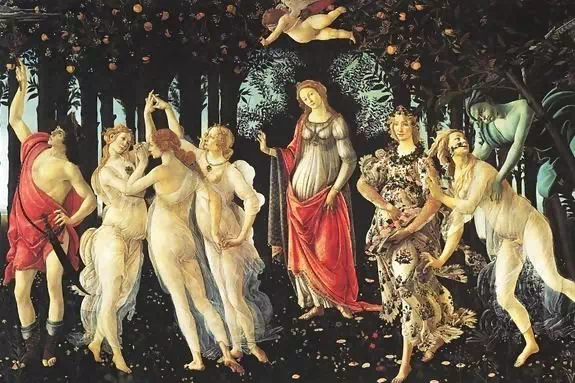
Primavera, also known as the Spring, is a famous painting by Sandro Botticelli. He was one of the employees of Medici in Italy.
It depicts nine figures from classic mythology celebrating the spring season joyfully in an orange grove. In the center, there is the Goddess Venus with an ideal look of the woman of the contemporary time. Above her head, there is her son Cupid, blind and with his arrow.
On her left Mercury is standing looking at the oranges and beside him, the three Graces are playing. On another side, Zephyrus, Chloris is there and he just transformed her into Flora.
Wheatfield with Crows by Vincent Van Gogh
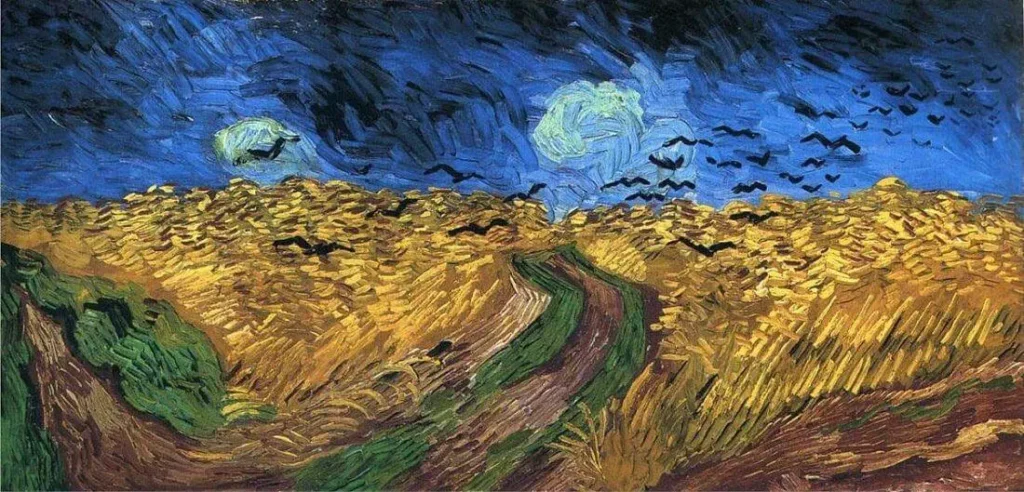
Wheatfield with Crows is believed to be the last work of Van Gogh painted in July 1890. He used his double-square canvas that he started using shortly before his death for this painting.
The painting depicts a Wheatfield that opens out with three paths evoking the great confusion of a traveler which path to choose. A flock of crows is there on the field creating a dynamic effect in the painting. Arguably they are the most powerful element here. The signature style of Gogh in using vibrant colors is also part of it.
The Tower of Babel (Great) by Pieter Bruegel The Elder

The Tower of Babel (Great) is one of the three paintings by Pieter Bruegel, the Elder. The first painting is lost and now there are only two of the arts existing. It depicts the Tower of Babel that is described in the Book of Genesis. It was built by a monolingual community.
Pieter Bruegel has painted the construction with several small details making it an authentic portrayal of the biblical story. It is an oil painting and now belongs to the Kunsthistorisches Museum, Vienna.
A Cotton Office in New Orleans by Edgar Degas
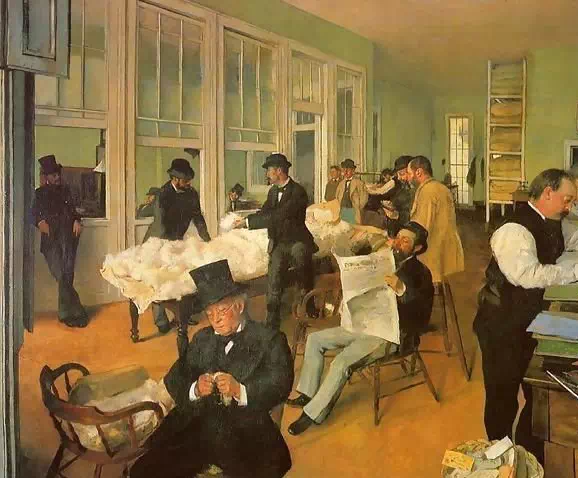
A Cotton Office in New Orleans is a famous oil painting by Edgar Degas. In 1872, he traveled to New Orleans and visited his uncle’s cotton office. Here he depicted a working day of the office.
A man is testing the quality of the cotton, another man is reading a newspaper presumably and others are doing their works as well. In his time it was not so common for a French to visit America and paint subjects from there. But Degas did it and got success eventually.
Bacchus and Ariadne by Titian

Titian was one of the major renaissance painters and a member of the 16 century Venetian School. Bacchus and Ariadne is an oil painting done for Alfonso I d’Este, Duke of Ferrara who demanded paintings based on classics. It is one of the examples of Venetian paintings.
It depicts an event taken from the stories of Ovid and Catullus that tells about the meeting of the Wine God, Bacchus, and Princess Ariadne the daughter of King Minos in Naxos. Here she is deserted by her lover, Theseus, and later found by Bacchus and his drunken companions. He has arrived riding two Cheetahs and immediately declares his love for her. The dramatic moment is depicted by Titian vividly.
The Gross Clinic by Thomas Eakins

The Gross Clinic is an example of realist art produced by American artist Thomas Eakins. He visited the operation theater of Dr. Gross and later depicted it in his paintings. He has included himself in it as well wearing a white sleeved shirt and taking notes.
Eakins has presented the scene authentically putting some elements of drama to make the art more interesting. Now the painting belongs to the Philadelphia Museum of Art and the Pennsylvania Academy of Fine Arts.
The Two Fridas by Frida Kahlo
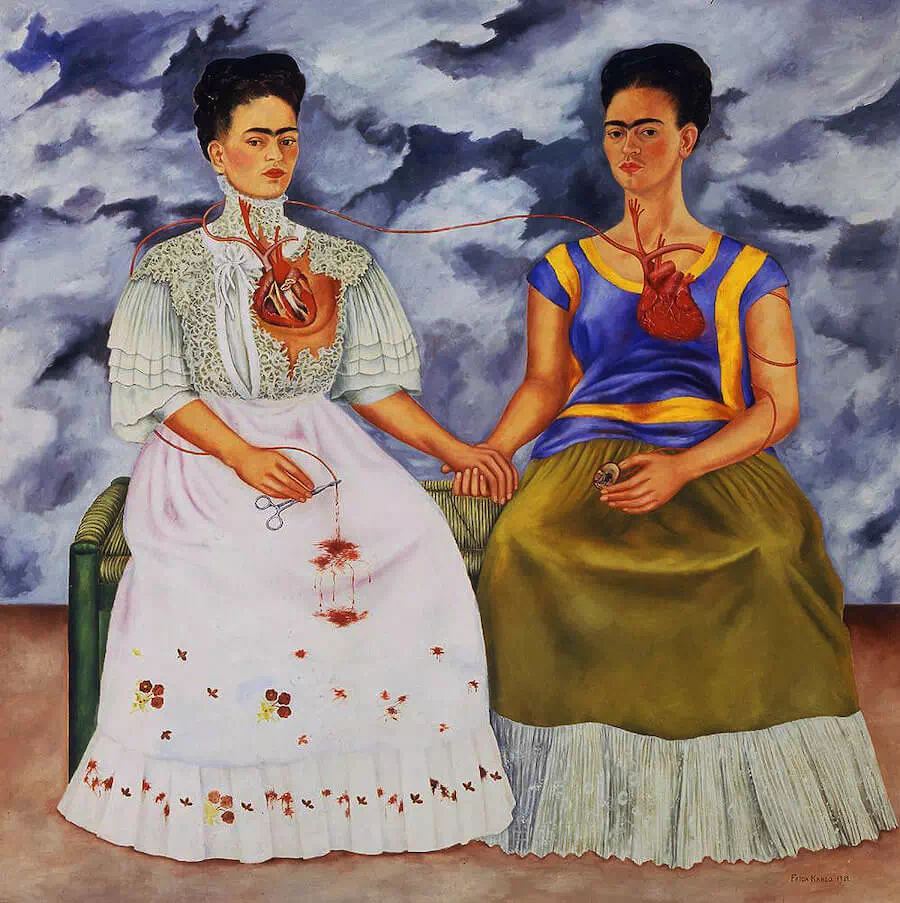
The Two Frida’s is one of the most famous paintings by Mexican artist Frida Kahlo. Here she depicted two different versions of herself one is weak, weary, broken Frida and the other one is strong, determined, and modern Frida.
She made the distinction notable by the dresses as one is wearing the traditional Tehuana and the other one is wearing contemporary Victorian dress. The Victorian Frida is holding a forceps in her hands and the other one is holding a small portrait of her ex-husband Diego Rivera.
Astronomer by Johannes Vermeer

The Astronomer is painted by Johannes Vermeer in 1668. Portraying the scientists, astronomers or philosophers was a recurring subject of contemporary painters. Vermeer painted an astronomer in his study book studying a globe. There is an open book in front of him on the table in a chapter about stars.
The table is covered with an exotic tapestry. The main source of light in the room is coming through the window creating a light and shadowy effect in the room. It is a beautiful portrayal of an astronomer engaged deeply in his studies. Now the painting belongs to the Louvre Museum, France.
Christ of Saint John of the Cross by Salvador Dali

Salvador Dali painted the Christ of Saint John of the Cross in 1951, depicting Jesus Christ on the cross. It is the most popular religious painting of Dali. Here Jesus is painted as a crucified figure, yet there are no nails or blood. He is shown in a dark sky being floated on a blue river where a boat and a boatman are waiting. Dali said that he got the image from his dreams.
The depiction of Jesus is inspired by the concept of the Trinity. Also, as his arms have created a triangle shape and his head a circle, it represents the unity of the universe according to the platonic allusion.
The Wounded Deer by Frida Kahlo
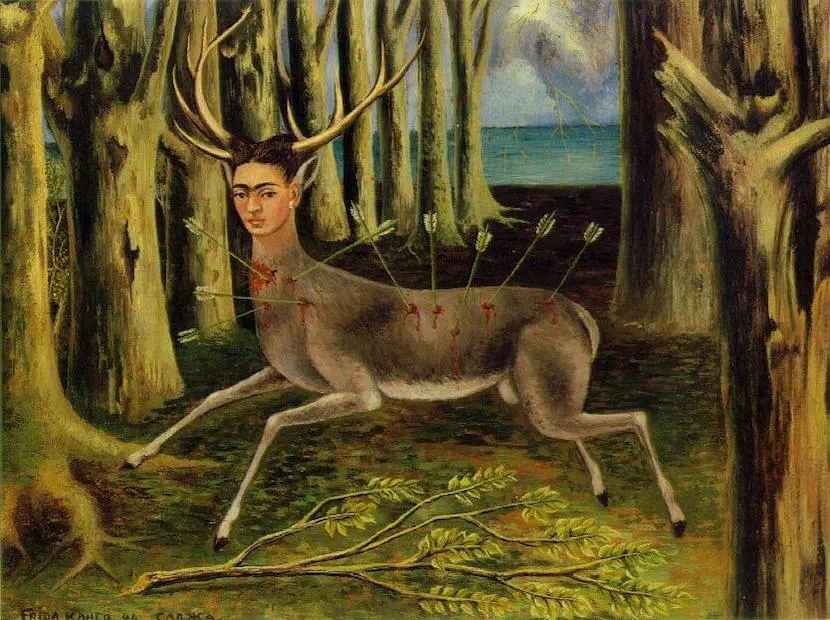
Frida’s paintings are often the representation of her troubled, miserable life. The Wounded Deer is among those paintings, painted in 1947 after she had an operation on her spine.
The painting shows a deer with the face of Frida, shot by several arrows surrounded by broken branches and dead trees. However, there is the blue sky as well but it is very far away and almost impossible for the deer to reach there.
Paris Street in Rainy Weather by Gustave Caillebotte

Paris Street in Rainy Weather is the best-known work of Gustave Caillebotte, a large oil painting of 10 feet in width. Caillebotte was involved in the impressionist movement and he was interested in realism as well. However, he was fascinated with photography and in this particular painting, he has used a similar style of photography.
The couple in the foreground is depicted more clearly than the people in the background. The background is blurry and seems to be out of focus. Caillebotte masterfully depicted the new building designed by Baron Haussmann and commissioned by Napoleon III to give the city a new look. Now the painting is permanently housed in the Art Institute of Chicago.
The old guitarist by Pablo Picasso

Picasso painted The Old Guitarist in 1903 during his Blue Period living in poverty and mental turmoil. It depicts a dark ambiance with a ghostly figure holding guitar in his hands. Notably, Picasso painted the human figure in blue which he took as his signature color during the Blue Period.
But he kept the guitar in a warm color. The interpretation tells us that the reason behind the warm color of the guitar in contrast with the blue color of the man is the guitar is the only way that can help him overcome his situation.
Water Lilies by Claude Monet

Water Lilies is a series of 250 paintings by Claude Monet, the famous French impressionist. Like Gogh’s Starry Night, it is another iconic painting of impressionism. A fun fact is Monet bought a piece of land and built a pond there. Later he planted the water lilies before painting them in his series.
However, his painting bears the element of both impressionism and expressionism. His works inspired others to join the impressionist movement. The Water Lily series has given him universal recognition as well.
The Son of Man by Rene Magrittees

The Son of Man is a surreal painting by Belgian painter René Magritte. It is his best-known work depicting his self-portrait with an overcoat and a hat. There are several peculiar elements in the painting, for example, his left arm is looking like bending backwardly from his elbow.
His eyes are peeking over the side of the apple that is hovering in front of his face making it hidden. He is standing in front of a cloudy sky and a sea. At a glance, the painting is simple yet provokes ambiguity.
The Treachery of Images by Rene Magritte

The Treachery of Images is another surreal painting by Rene Magritte. It depicts a pipe and below it, the painter has written that “Ceci n’est pas une pipe”, or “This is not a pipe”. The most certain interpretation is that it is not a real pipe but a painting of the pipe. It represents the gap between the word and its meaning. The word we use for items are entirely arbitrary and that causes the gap.
The Treachery of Images is among the series of word-based paintings where he wrote small notes under every art.
No. 5, 1948 by Jackson Pollock

No 5, 1948 by Jackson Pollock is an abstract painting making it one of the most paintings in the world. It is a pioneering work in the early abstract expressionist movement. Pollock painted in with the drip method which helped him to be more psychologically connected with it.
That is why it is also known as ‘action painting’ and one of the best of its kind. However, the peculiar method of his painting became so popular that he was later dubbed ‘Jack the Dripper’.
Composition with Red Blue and Yellow by Piet Mondrian
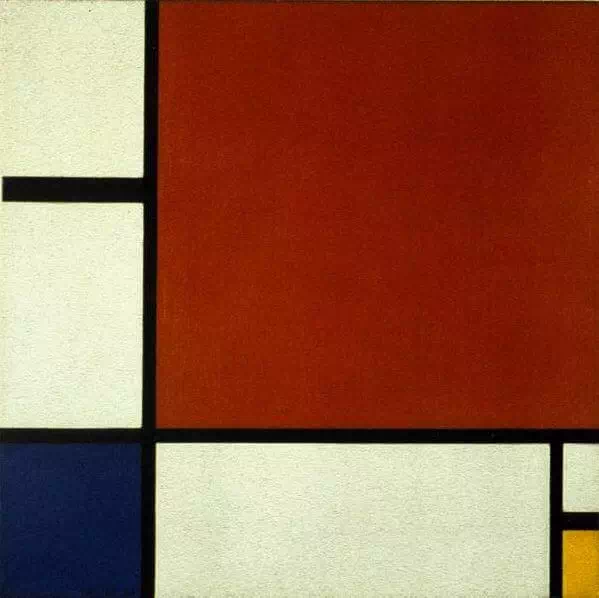
Composition with Red Blue and Yellow is an abstract art produced by Piet Mondrian in 1929. He made the style popular and it became his signature and iconic style. It is known as the Neoplasticism depicting some bold colors with black borders with thick brush works.
The objective behind such a composition is to aesthetically achieve the balance of contrastive colors. However, it remains one of the best examples of abstract paintings worldwide.
Ophelia by Sir John Everett Millais

Ophelia is an iconic character from Shakespeare’s Hamlet. The famous British artist sir John Everett Millais depicts her singing while drowning in the river. She is surrounded by different flowers and tiny plants.
Though Shakespeare did not show the scene on the stage, Millais portrayed her from his imagination. The flowers scattering beside her represent the purity, loveliness, and innocence of Ophelia. However, it has painted around 1851 in the collection of Tate Britain.
Salvator Mundi by Leonardo da Vinci
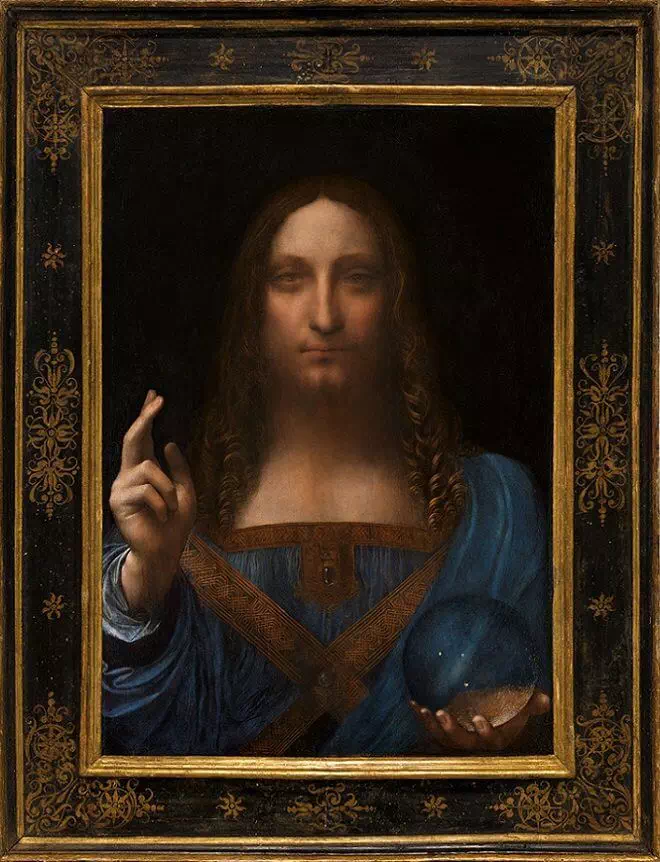
Leonardo Da Vinci painted Salvator Mundi or ‘the savior of the world’ around 1499 to 1510 presumably for French King Louise XII. It is a 26inch oil-on-panel painting that shows the figure of Jesus Christ clad in a renaissance-style robe. In one hand he holds a crystal orb and the other hand shows the cross. The original painting was long lost before it was restored and exhibited in the National Gallary of England.
However, on 15 November 2017, it was presented at an auction and sold for US $450.3 million making it the most expensive painting sold in any public auction.
The Self Portrait with Thorn Necklace and Hummingbird by Frida Kahlo

Self-Portrait with Thorn Necklace and Hummingbird is another portrait of Frida Kahlo done in 1940. Here, she has depicted her image with several symbolic elements that made the painting an outstanding one. She has a thorn necklace around her neck being held by a monkey.
On the other side, she has a black cat with an aggressive look. A hummingbird is hanging under her neck with the thorns. Frida’s face is calm and sober here. All elements symbolize her painful life caused by an accident that physically crippled her and her divorce that mentally broke her.
The Peaceable Kingdom by Edward Hicks

The Peaceable Kingdom is a naïve art by Edward Hicks depicting a biblical prophecy of spiritual and earthly harmony. It is an oil painting created in 1826.
It shows the wolf and a lamb is sitting together, a baby is leading a lion and a calf, a cow and lion are eating straw together. The peaceful condition of all the animals along with humans is from the prophecy described in Isaiah. In the background, William Penn is enacting a treaty with the Native Americans.
The Ninth Wave by Ivan Aivazovsky
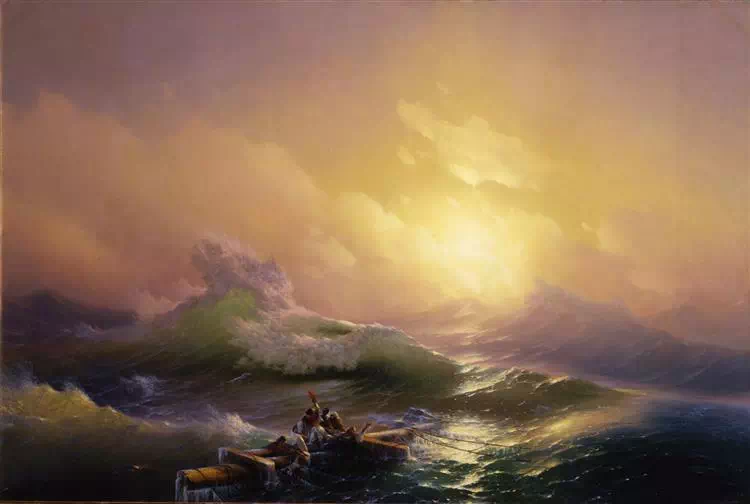
The Ninth Wave is a beautiful painting by Russian-American painter Ivan Aivazovsky. He was a marine painter and The Ninth Wave is one of his most prominent paintings.
It depicts a boat surviving on the sea after a stormy night. Interestingly the debris appeared in the shape of a cross symbolizing Christian salvation after a life of sin and suffering. It also shows the beauty of the sea with his brilliant skill of art.
Mr. and Mrs. Andrews by Thomas Gainsborough

Mr. and Mrs. Andrews is one of the most celebrated paintings of Thomas Gainsborough done in 1750. It is a double portrait in landscape format. The man and the woman are a newly married couple sitting in a fresh and charming pastoral environment of Essex.
Behind the river, Stour is flowing. The painting was chosen among the other four to represent British art in Paris during the coronation ceremony of Queen Elizabeth II in 1953.
Pollice Verso by Jean Leon Gerome

Painted in 1872 Pollice Verso is an oil-on-canvas painting by French artist Jean Leon Gerome. It depicts a defeated gladiator raising his figures pleading for mercy. The spectators are giving him a thumbs-down gesture because of being defeated. Later these paintings inspired statues, films, and pictures.
The victorious gladiator is one of the Murmillo’s who was adopted to replace other previous gladiators. Now it is permanently housed in Phoenix Art Museum, Arizona.
The Embarkation to Cythera by Antoine Watteau
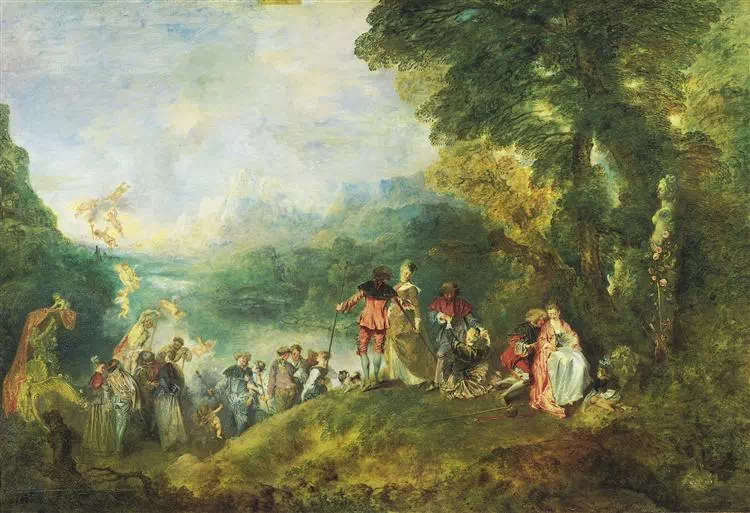
The Embarkation for Cythera is also known as the Voyage to Cythera or the Pilgrimage to the isle of Cythera is a brilliant art by French Rococo artist Antoine Watteau. It depicts the “fête gallant”, which was a celebration by the French aristocratic people during the time of King Louis XV.
The pastoral setting does not provoke a sense of realism rather more like a fantasy world. The use of soft brush strokes has made it hazy and dreamy. Now it is housed in Louvre Museum, France.
A Bar at the Folies Bergere by Edouard Manet
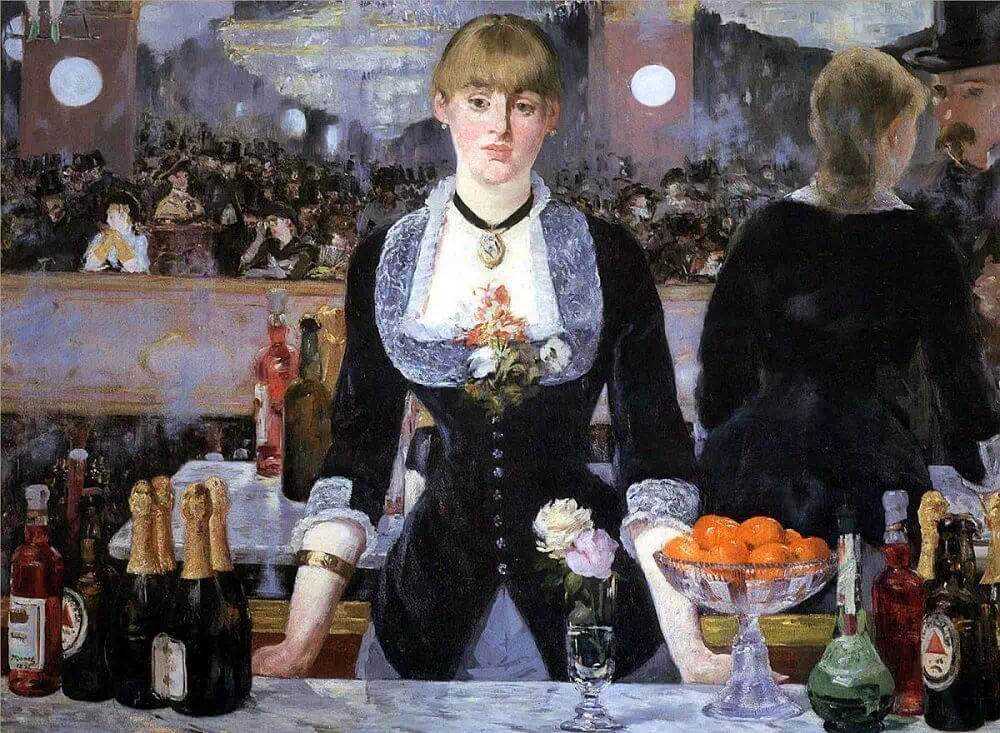
A Bar at the Folies Bergere is the last work of Edouard Manet painted in 1882 for his friend, the composer Emmanuel Chabrier. He was interested in depicting urban life through his painting and this particular art bears its significance. This painting is one of the finest examples of realism as well.
This artwork depicts a female figure, a barmaid standing before a window at The Folies-Bergère. It was a famous variety show venue in Paris. Through the mirror, another figure is seen who is a customer dressed in highly fashionable attire. Behind the barmaid, the large hall of Folies Bergere can be seen filled with patrons and visitors.
The Laughing Cavalier by Frans Hals
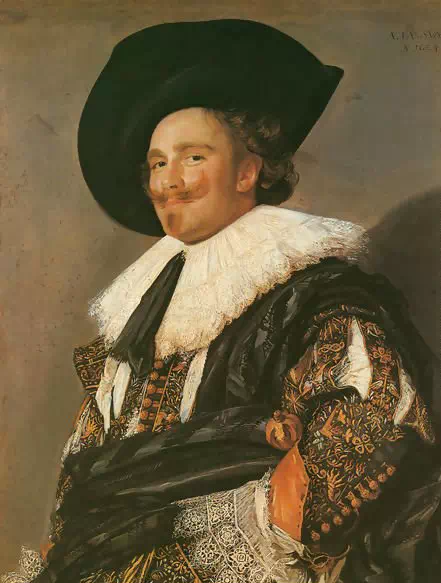
The Laughing Cavalier is a portrait by Frans Hals, the golden age painter of the Netherland. It is an oil-on-canvas painting and one of the best among all male portraits. Now it is a part of the Wallace Collection, London.
The identity of the subject of this painting is unknown. It creates an illusion that the man is laughing the name suggests it. But the upward turned mustache, his tiny beard, and his bright eyes provoke humor.
The Fox by Franz Marc

The Fox is one of the most famous luxury paintings for home by renowned German painter Franz Marc. It is an example of his cubist paintings where he experimented with abstract styles. Here he has violated the realistic and natural forms and presented a prismatic picture with bold and vibrant colors.
Marc was interested in painting animals and many of his subjects are dogs, horses, and foxes. He made them symbolic and relatable to the human world.
The Lady of Shalott by John William Waterhouse

The Lady of Shalott by John William Waterhouse is a famous cute painting that depicts the fictional character Lady of Shalott from Alfred Lord Tennyson’s poem ‘The Lady of Shalott.’ She was mysteriously cursed and lived in a tower weaving and singing.
One day she saw Sir Lancelot through her magical mirror and rejected her obligation. She looked at him directly and that brought the curse upon her. Later she died floating on a boat. Waterhouse has painted it in landscape style through oil paint on canvas.
The Night Watch by Rembrandt
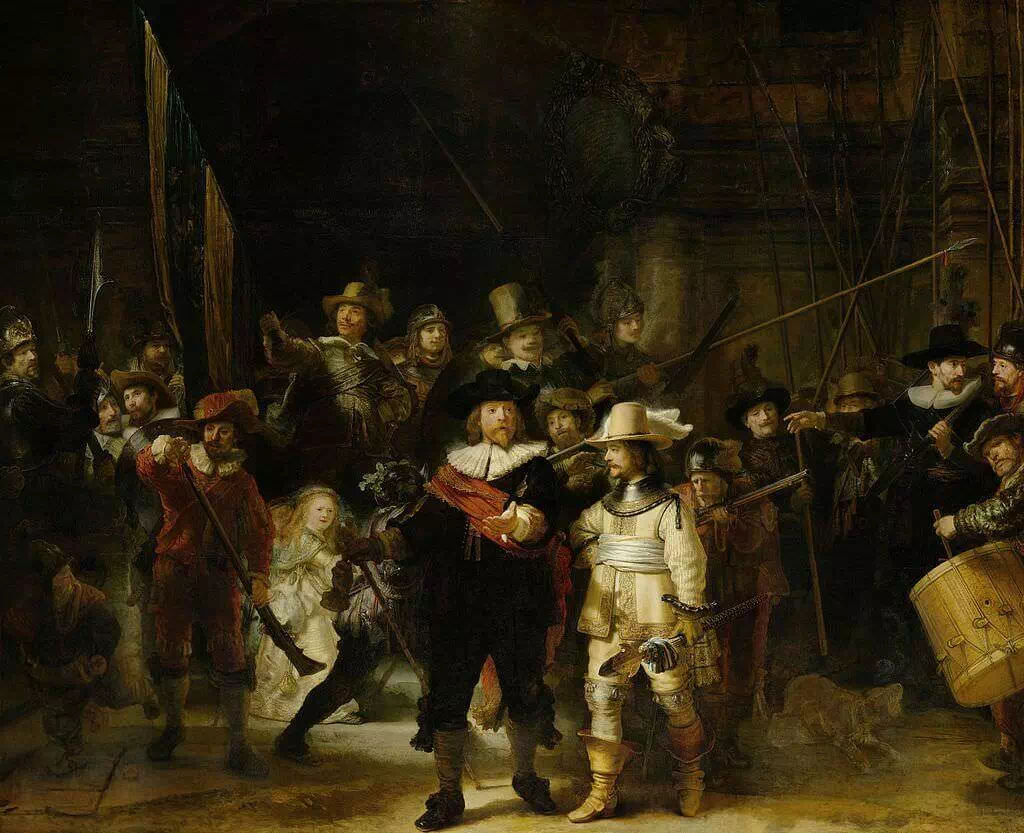
The Night Watch is another masterpiece from the Dutch golden age by Rembrandt Van Rijn. The night watch is the Militia Company of District II under the command of Captain Frans Banninck Cocq or The Shooting Company of Frans Banning Cocq and Willem van Ruytenburch.
The painting is depicting a group of men who are civic guardsmen in the city of Amsterdam. They were the guards of the gate, and streets and maintain orders inside the city. There is a mysterious woman among those guards wearing a golden dress and a white chicken hanging upside down. The girl is the personification of the company rather than being a real person.
The Card Players by Paul Cezanne
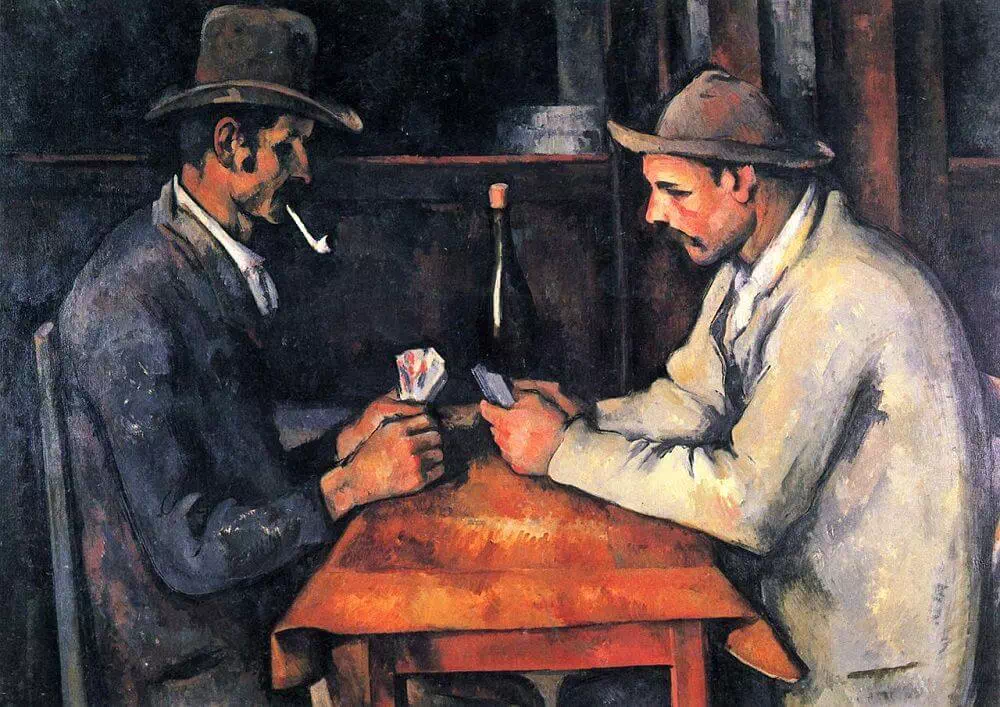
The Card Players by French impressionist and modernist painter Paul Cezanne is a series of five oil paintings each in different content and size. He started working on it in 1890 while he was staying in his father’s estate at Aix-en-Provence.
It depicts two peasants smoking pipes and playing cards. They do not seem to be engaged in conversation. Their concentration is solely on playing the cards. Instead of painting subjects on grand subjects, Paul chose the humble figures as the subject of his iconic art.
The Grand Canal, Venice by J.M.W Turner

The Grand Canal, Venice is a famous painting of the dream city of Venice by J.M.W Turner. He painted it on his second visit in 1833 presumably. He has portrayed one of the canals with the natural setting, dramatic lights, and colors. The sky is blue and clear and the water is calm and silent. There are some boats which are the transport system of the city.
It is appreciated worldwide because of the mastery of portraying a simple thing dramatically and artistically.
A Boat Passing A Lock by John Constable

A Boat Passing a Lock is a famous painting by John Constable depicting a boat in the River Stour. A lock keeper is lowering the level to enter the chamber before the lifting of the upper level. The Dedham Church tower can be seen at distance.
A man is the central figure of the painting wearing a red waistcoat trying to open the gate. His appearance makes him look like a boatman. The sky is clear and blue which has made the painting the perfect landscape of rural areas of England.
So this is our list of 100 famous paintings of the world. As we have confessed earlier, ranking is not easy and many of the paintings may have been missed by us. Yet we hope you have enjoyed reading about the paintings.
Did you find your favorite one? Here we did not count the famous living painters today but rather the famous artists of all time.










